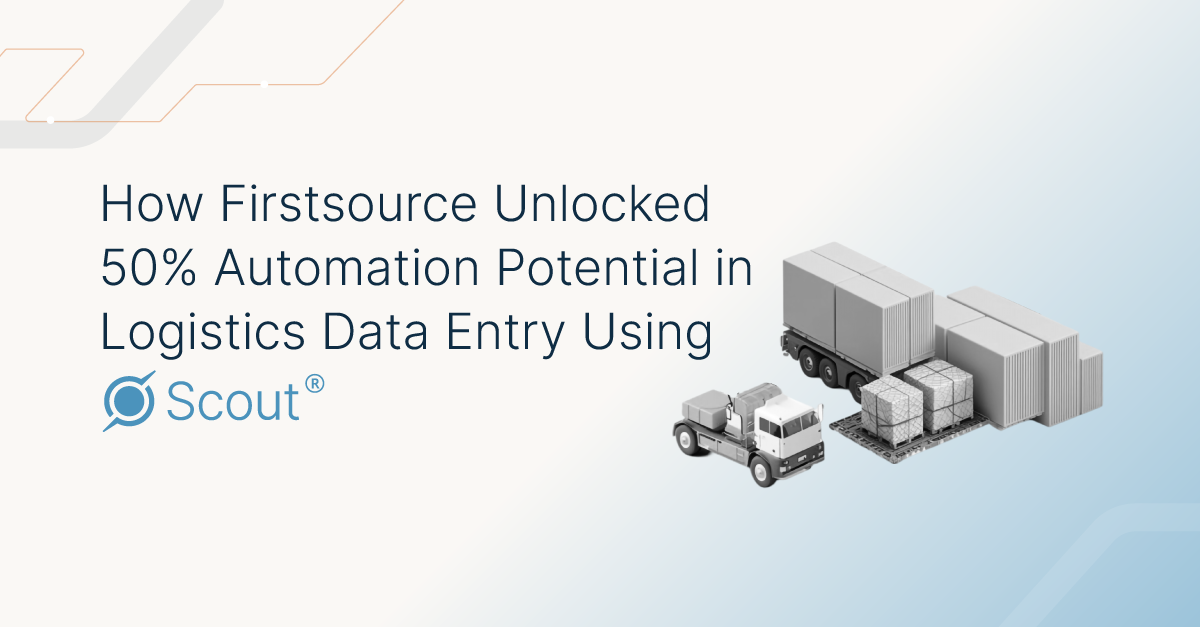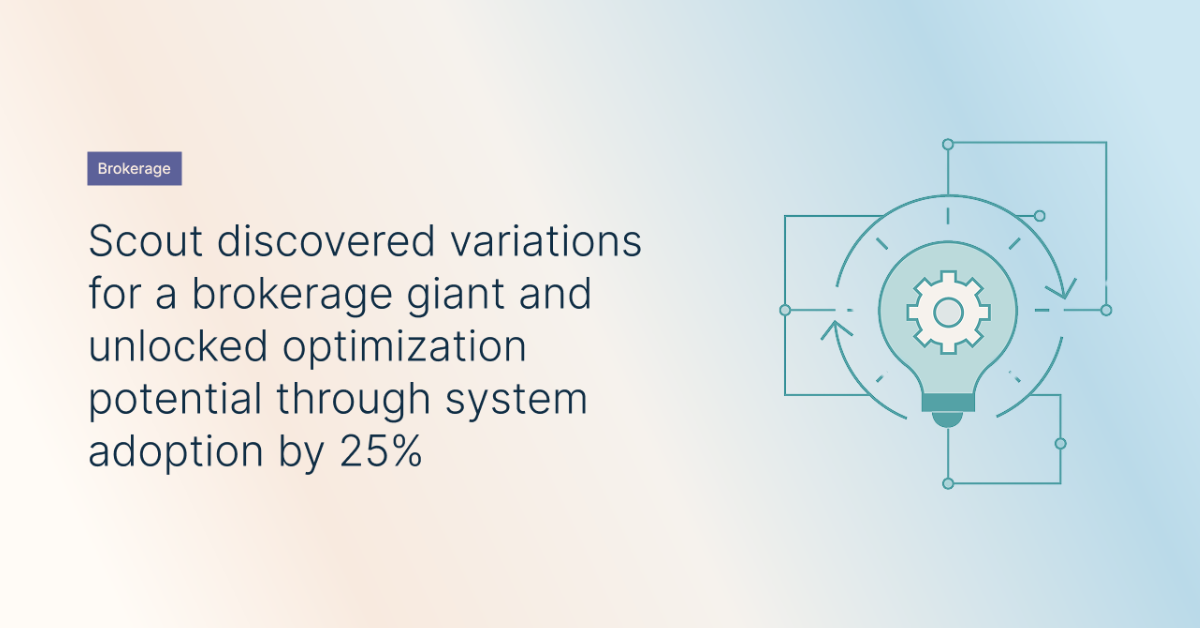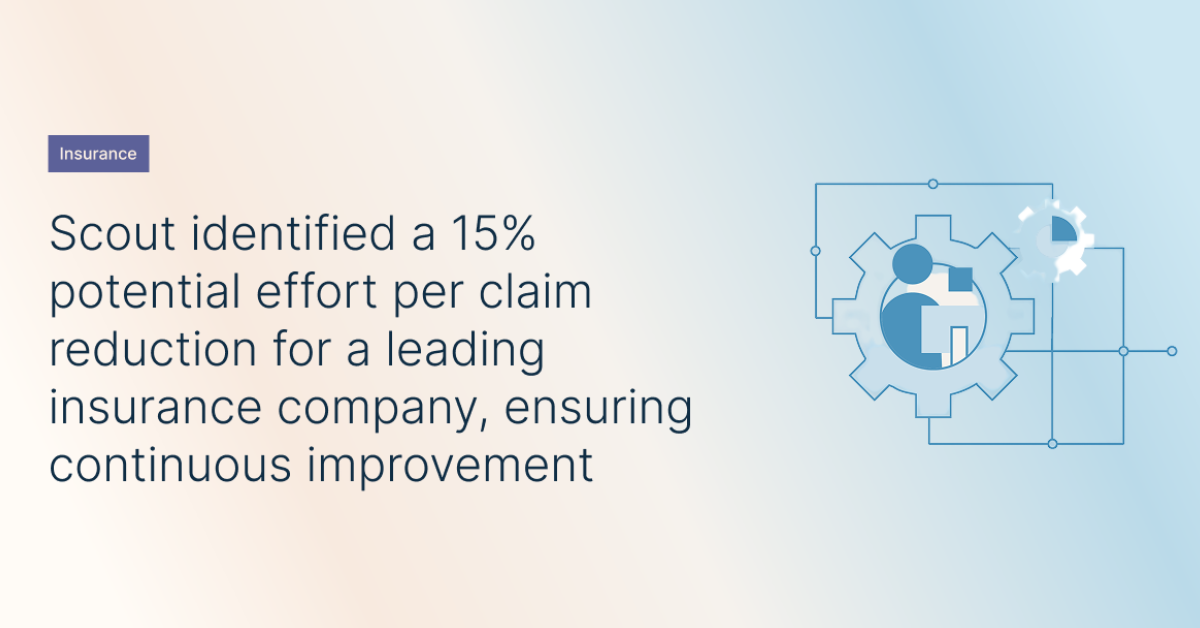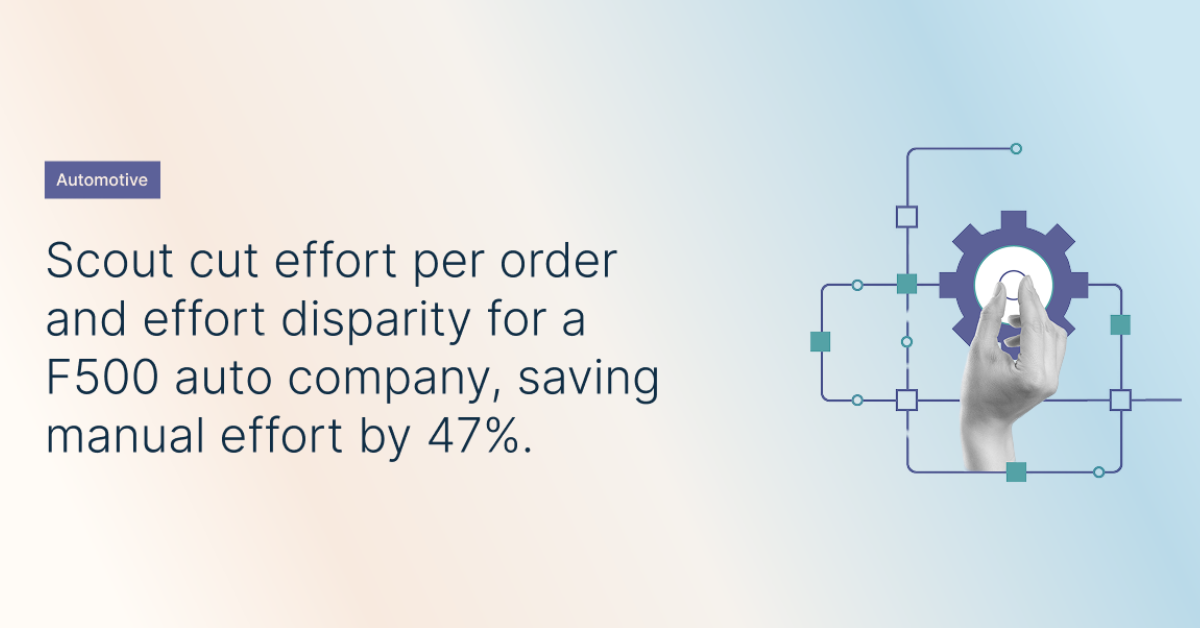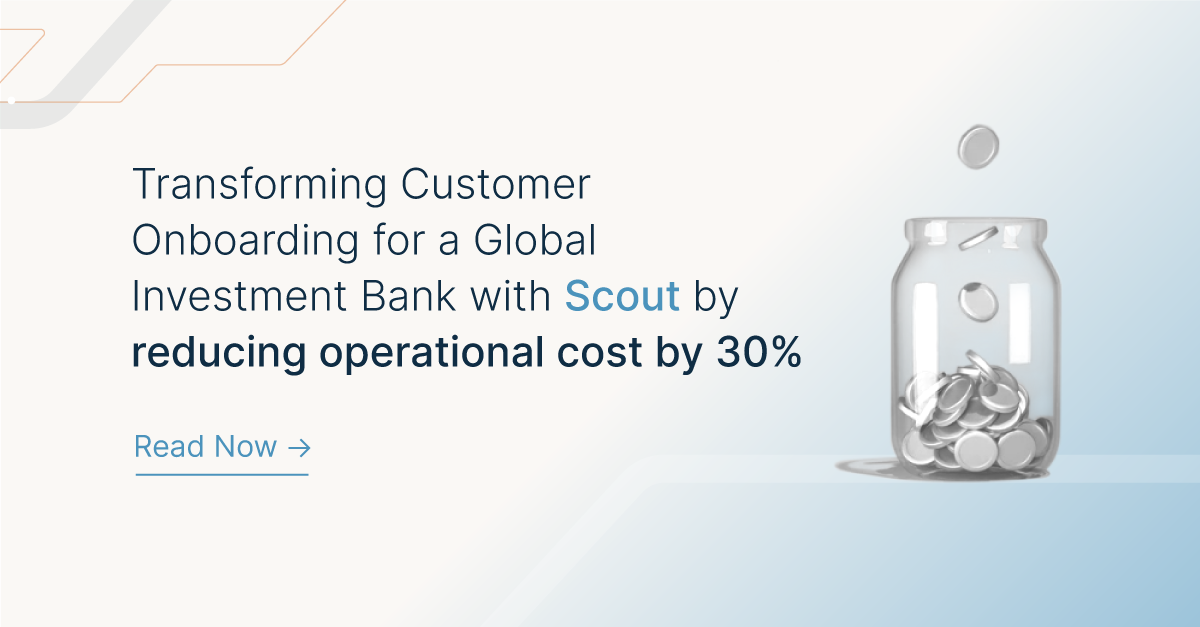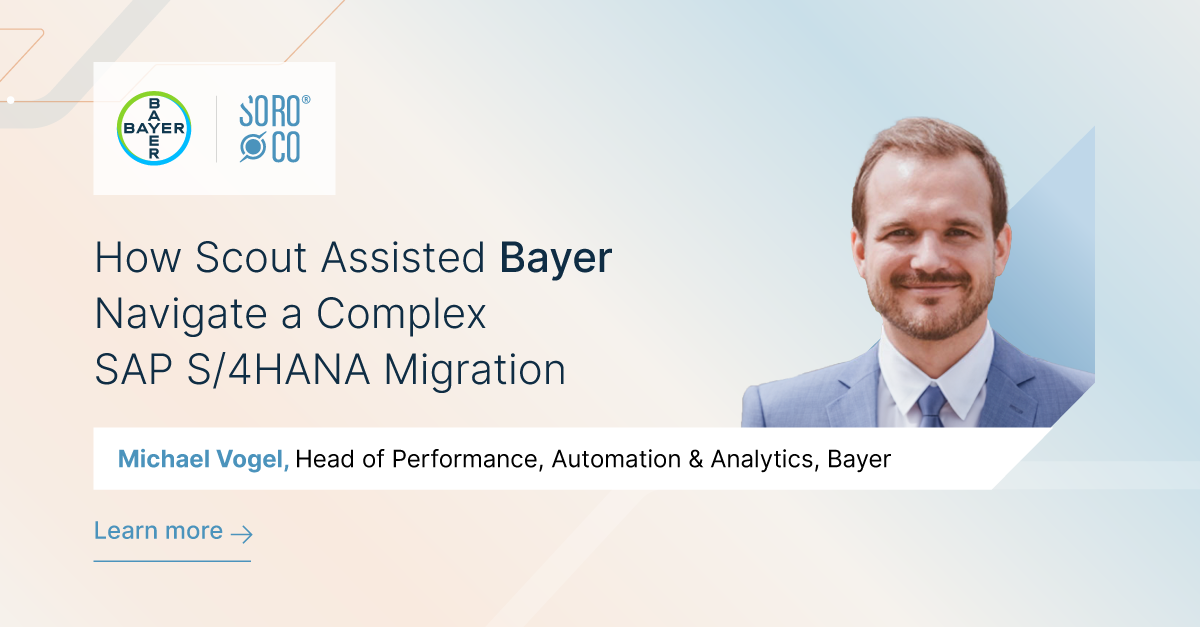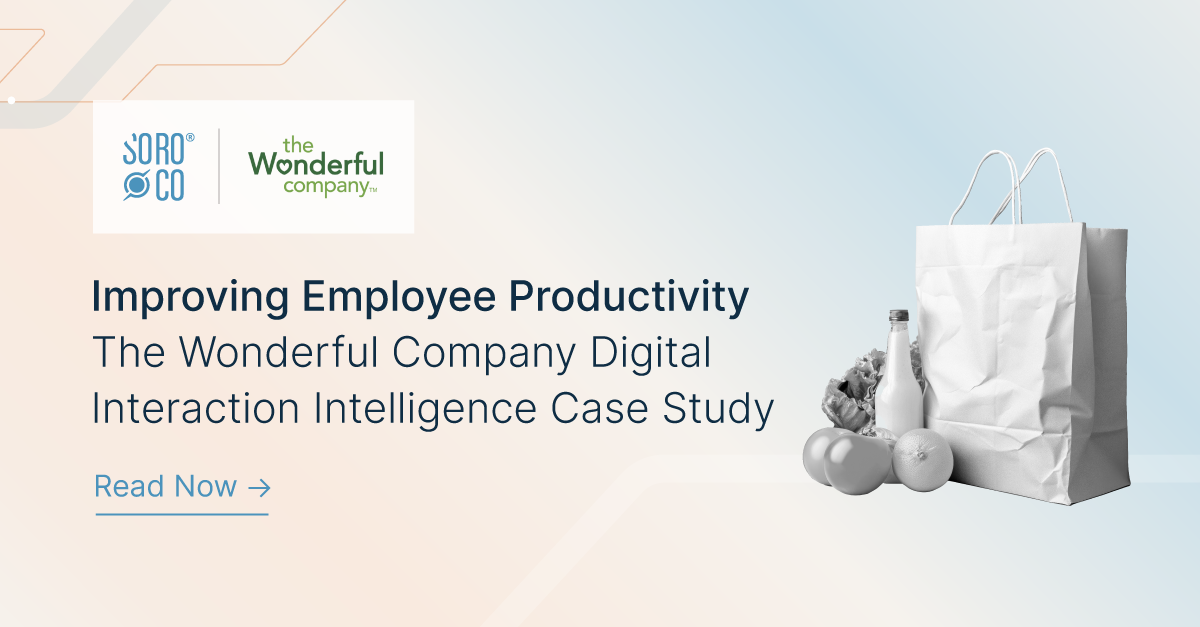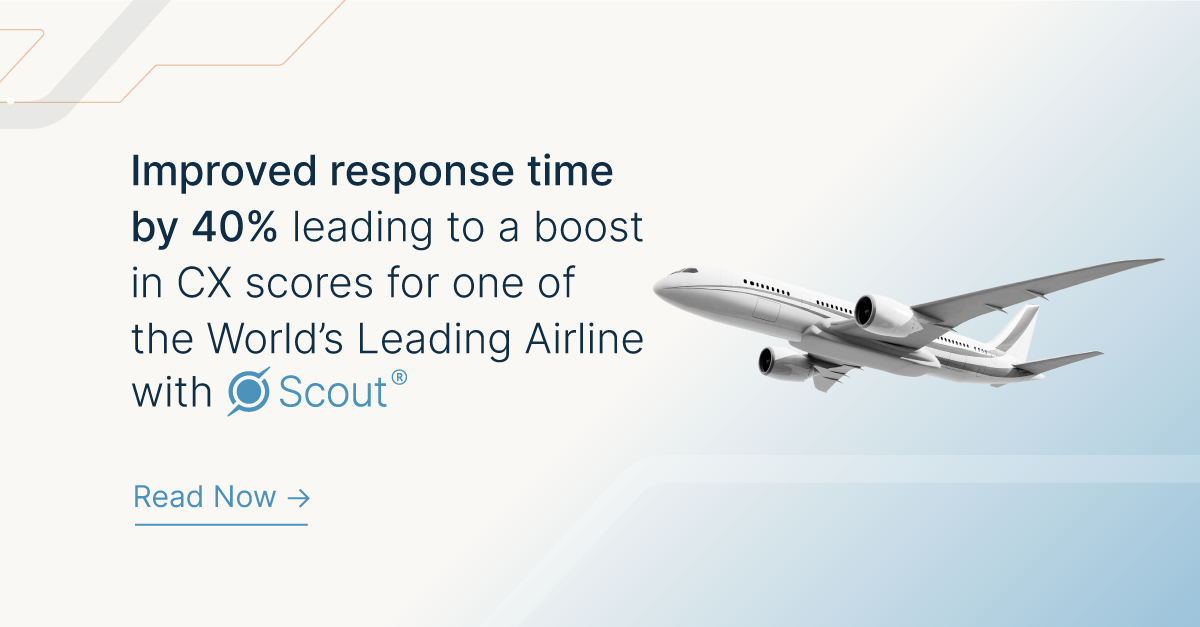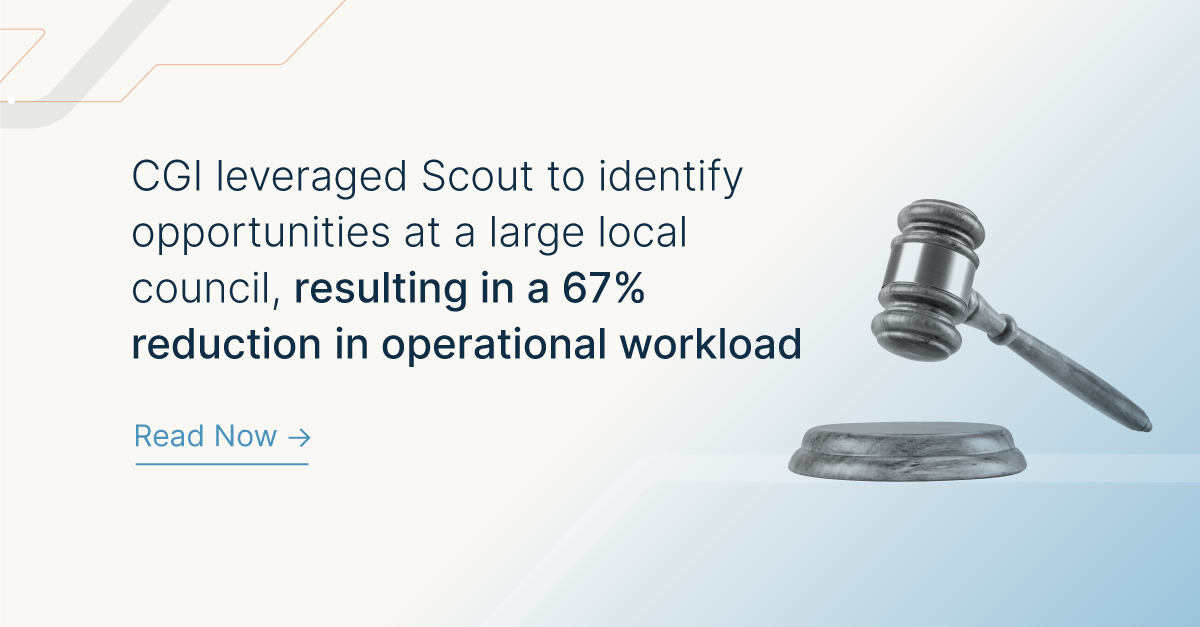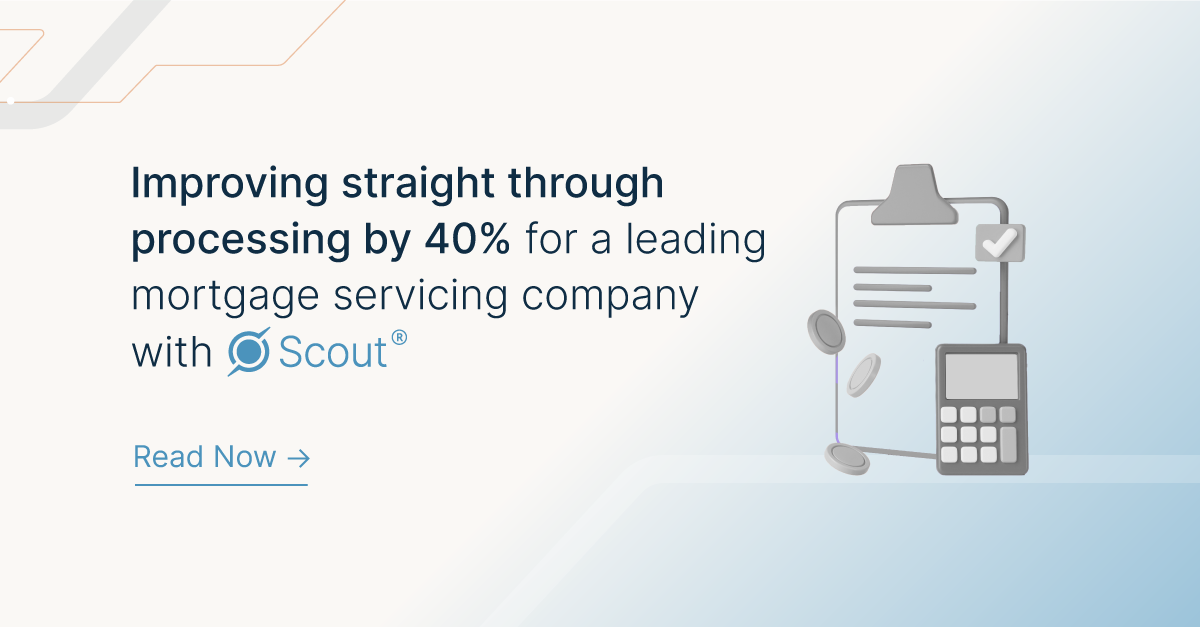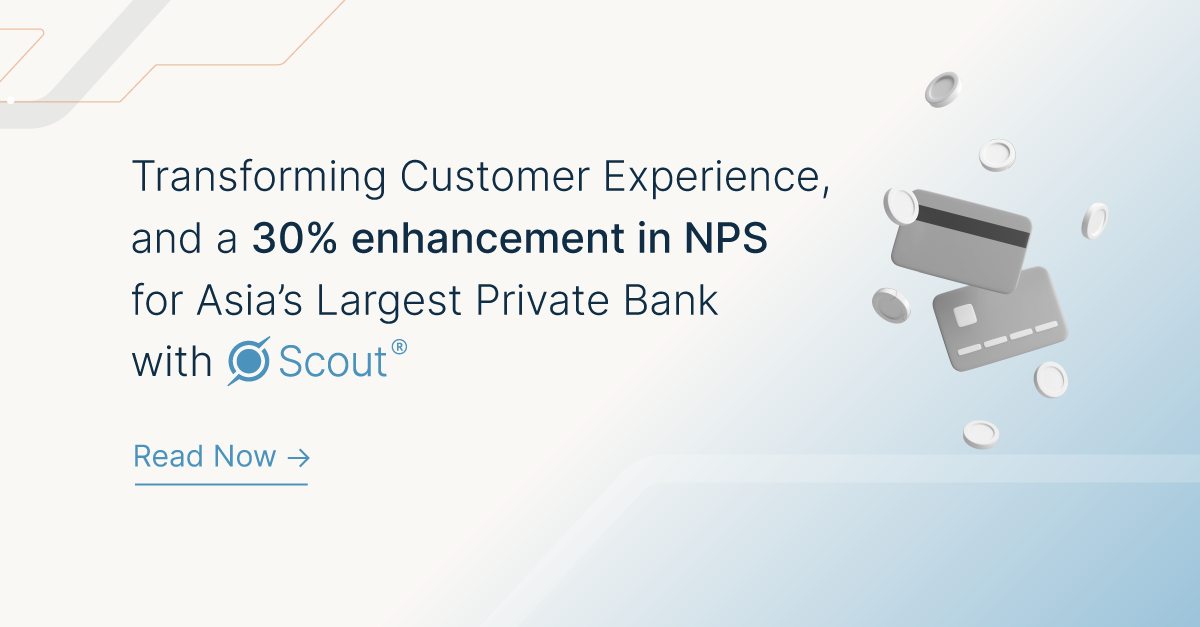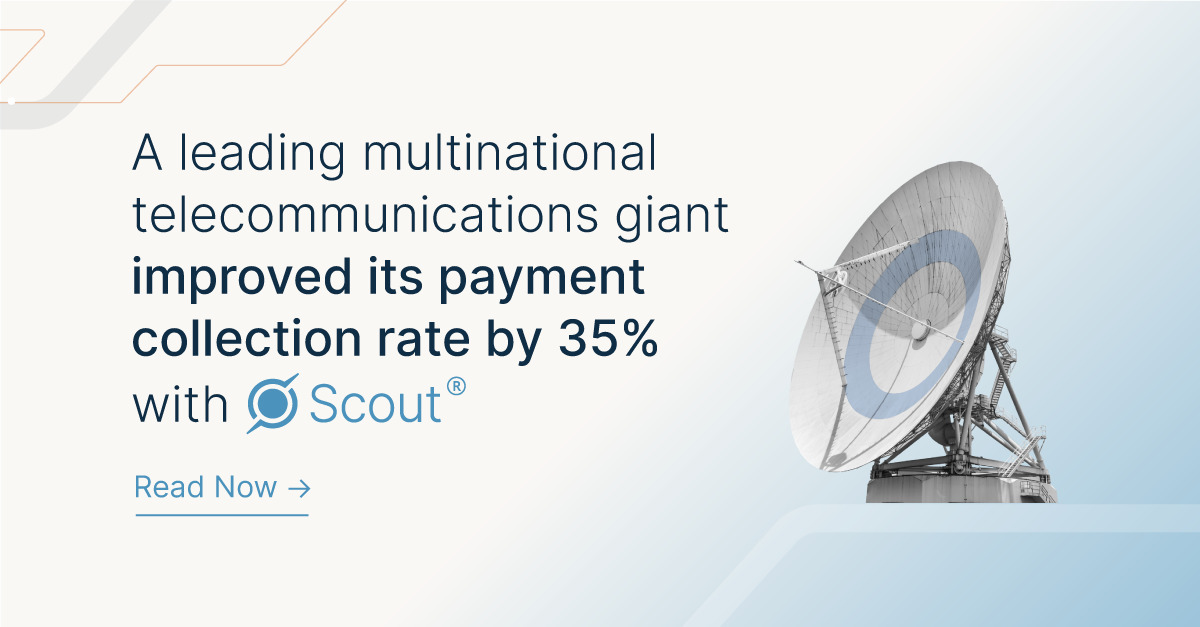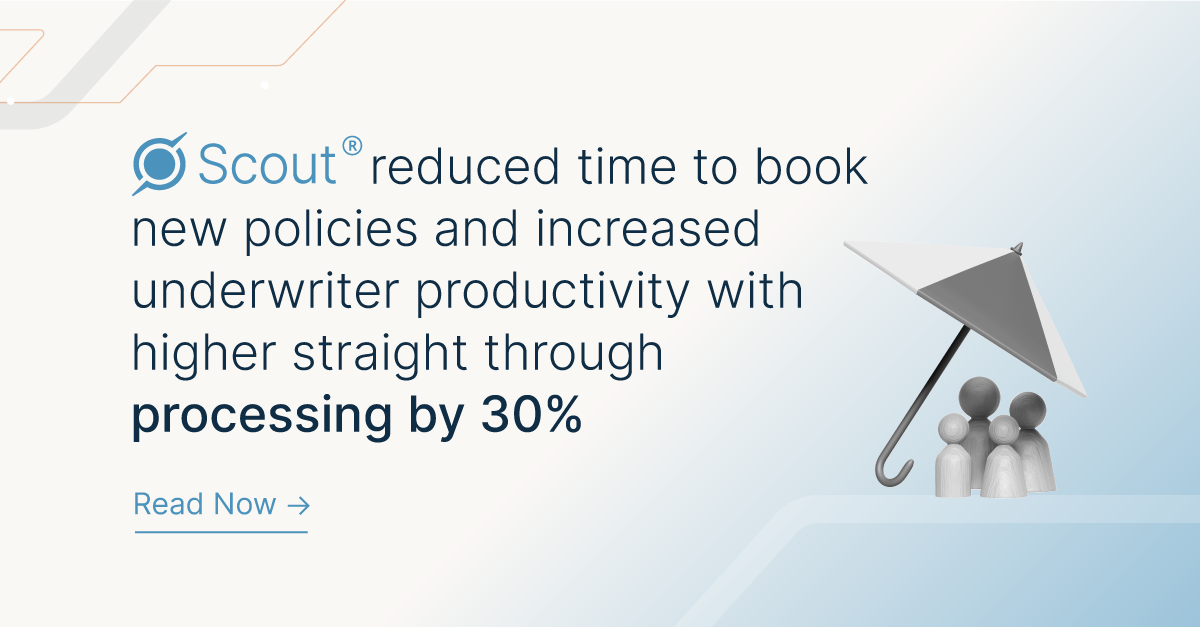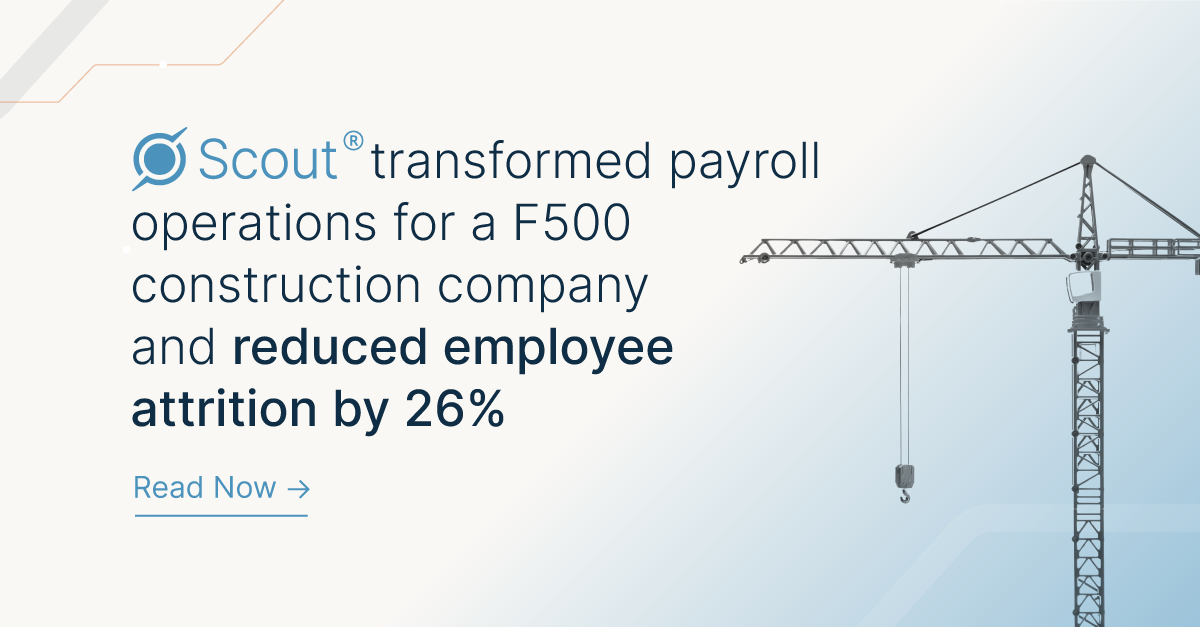Manufacturing How a Global Manufacturing Leader Unlocked Millions in Hidden Sales Capacity The Challenge:Hidden Inefficiencies Draining Selling Time Are your field sales teams truly spending their time where it matters? For one of the world’s leading manufacturing companies, the answer was no. Despite healthy market demand, sales performance had plateaued. Area Sales Managers (ASMs) across Germany, Poland, and the UK were buried under administrative work — juggling reports, CRM updates, and email threads instead of engaging customers. Leadership lacked objective data visibility into how time was being spent making it hard to drive accountability and sales efficiency. Traditional sales analytics showed what was closing — not why productivity was stalling. Industry Manufacturing Timeline 6 weeks Function Sales Ops The Root Cause: Fragmented Digital Workflows Scout’s diagnostic revealed a striking pattern: 60% of ASM time lost to non-core digital tasks 126% higher effort variance across regions 2% of customers driving 30% of total email volumeThese inefficiencies weren’t visible in any existing system. The company needed a way to see how work actually happened — across tools, apps, and regions — to reclaim lost selling capacity. Enter Scout uses granular, comprehensive and user anonymized user interaction data across all systems — clicks, app usage, and workflow transitions, coupled with an AI-powered recommendation engine that provides you surgical insights to streamline customer lifecycles by increasing productivity and creating 30% more time for customers. See, down to the minute, how your team spends their day. Get recommendations on which behaviors to prioritize and which to eliminate. Within six weeks, Scout delivered a live, factual map of how sales work actually happened and the bottlenecks in the work. Within 6 weeks Scout delivered a privacy-safe map of how sales teams were truly working — and where time was being lost. Key Insights Uncovered Scout’s data-driven visibility exposed the hidden bottlenecks holding back growth: 60%+ of ASM time was spent on non-core administrative work. 2% of customers = 30% of total email load — showing disproportionate focus. 126% time variance across regions highlighted inconsistent processes. Clear opportunities emerged to automate, standardize, and streamline key workflows for faster deal cycles. For the first time, leadership had a single, factual source of truth on how work was being done — not how people thought it was being done. The Impact: Time Reclaimed, Growth Unlocked Scout’s insights powered targeted transformation initiatives across global sales operations: Standardized best practices across all regional teams. Automated repetitive admin workflows. Reallocated ASM time toward customer engagement, renewals, and upselling. Launched focused outreach for high-value accounts. These actions delivered measurable, rapid results: 30% more selling time unlocked per ASM. 25% higher productivity across regional teams. 15% increase in renewalsthrough focused outreach. $4M+ incremental revenue potential per region. 3.5x ROI achieved in under four months. 26K+ hours saved annuallyfor every 100 users. What started as a visibility challenge became a productivity breakthrough. Scout turned invisible digital work into actionable intelligence — transforming how the company sells, plans, and grows. The Outcome: From Digital Chaos to Sales Clarity Today, the organization runs a smarter, data-driven sales engine — powered by continuous visibility from Scout. What was once lost time is now productive capacity. What was invisible is now measurable. And what was fragmented is now unified. Replicated across 50+ global regions, this transformation continues to drive consistent growth, agility, and operational excellence at scale. In the Customer’s Words “Scout helped us see what no CRM could — the hidden patterns behind every click, email, and process. That visibility has changed the way we manage productivity.” VP, Sales Transformation, Global Manufacturing Leader From digital chaos to sales clarity — that’s the Scout advantage. See Scout in action. Schedule your demo now! Get in Touch
Category: Customer stories
How Firstsource Unlocked 50% Automation Potential in Logistics Data Entry Using Scout
Logistics How Firstsource Unlocked 50% Automation Potential in Logistics Data Entry Using Scout The Challenge A leading logistics company in the US, operating across multiple locations, was grappling with inefficient and inconsistent back-office processes. These inefficiencies led to increased time expenditure, revenue leakage, over 50% reduction in process accuracy, a suboptimal end-user experience, and ultimately high operational costs and production inefficiencies. Despite prior efforts using manual discovery methods to identify end-to-end cost optimization opportunities, the company was unable to achieve the desired level of transformation. Industry Logistics Timeline 6 weeks Function Data Entry Operations Attempted Solution before Scout The company initially relied on manual discovery to address its operational challenges. However, this traditional method yielded fragmented insights that failed to offer a holistic view of inefficiencies. It lacked the end-to-end visibility and advanced analytics needed to identify critical bottlenecks, and did not account for nuanced workflow variations across teams and locations. Enter Firstsource, a global services partner, deployed Scout to transform the shipment form validation process for a logistics technology client. Led by Firstsource’s automation and transformation team, the initiative focused on effort-intensive workflows involving multiple form types and frequent cross-system data transfers. Over six weeks, Scout uncovered hidden effort patterns, identified automation-ready workflows, and provided data-backed inputs to redesign standard operating procedures (SOPs). These insights empowered Firstsource’s Center of Excellence (CoE) to craft a transformation roadmap aimed at reducing manual effort by 50%, positioning them as a strategic enabler of operational excellence. Over 6 weeks Scout uncovered hidden effort patterns, and provided data-backed inputs to redesign SOPs. Objectives: Enabling Effort Efficiency Through Firstsource-Led Discovery Pinpoint manual effort hotspots and repetitive work patterns Identify automation-ready workflows across form types Quantify time spent on data entry, navigation, and referencing tasks Equip Firstsource’s internal CoE with step-level, data-backed insights to drive change Scout Insights: A Clearer Picture of Effort Distribution High Manual Effort Across Steps Scout revealed that 57% of user effort was spent on repetitive actions within a single application, while another 42% was spent navigating across 25 screens or tabs to reference and input data. These patterns pointed to opportunities for workflow redesign and data integration – particularly in legacy form processing. Expert vs. Standard User Variance Standard users took 1.2–2x more time and steps per task compared to process experts, indicating a lack of standardization. This variance highlighted the opportunity to codify expert behavior into improved SOPs. Fragmented Application Usage Significant effort fragmentation was observed across internal systems and an external verification portal. Frequent screen / tab switching for simple tasks introduced delays and increased error risk, underscoring the need for streamlined workflows and interface design. Scout Recommendations helped Firstsource turn Insight into Action Introduce Self server OCR BOT Introduced a self-serve OCR bot which can read the key info and generate a comparison report, eliminating over 70% of screen switching and data referencing effort. Automate ‘New Form’ Processing The “New Form” workflow—structured, rules-based, and highly repetitive—was identified as the most automation-ready. Automating this process can free up analysts to focus on complex cases and exceptions. Standardize Execution Patterns Benchmark high-performing user behavior to reduce variability. Drive consistency in navigation, data validation, and task execution across the team. Redesign SOPs & Training Use real interaction data—not assumptions—to update SOPs and develop targeted training programs. This ensures alignment with actual user behavior and improves adoption. Potential Business Impact: Unlocking Tangible Results for the Client By acting on Scout-driven insights, Firstsource helped define a transformation roadmap that is expected to deliver: ~50% reduction in manual effort across data entry operations A validated automation roadmap with use-case level granularity Faster turnaround times for SLA-bound transactions Improved consistency and accuracy in execution across the team Scout empowered Firstsource to move beyond anecdotal views and lead a transformation grounded in real user behavior – delivering targeted automation, streamlined operations, and scalable change for the client. What’s next? The success of this Firstsource-led Scout deployment lays the foundation for scaled adoption across adjacent workflows and faster automation rollout. For the client, the focus now shifts to executing the roadmap, capturing effort savings, and using this engagement as a model for broader transformation. See Scout in action. Schedule your demo now! Get in Touch
brokerage industry
Scout discovered variations for a brokerage giant and unlocked optimization potential by 25% through system adoption
insurance industry
Scout identified a 15% potential effort per claim reduction for a leading insurance company, ensuring continuous improvement
automotive industry
Scout cuts effort per order and effort disparity for a F500 auto company, saving manual effort by 47%.
Transforming Customer Onboarding for a Global Investment Bank with Scout by reducing operational cost by 30%
Investment Banking Scout transforms customer onboarding for a global investment bank by reducing operational cost by 30% Investment Banking Transforming Customer Onboarding for a Global Investment Bank with Scout by reducing operational cost by 30% The Challenge A leading U.S.-based investment bank aimed to optimize its Global Markets Operations, with a focus on improving customer onboarding and trade settlement processes. The initiative sought to analyze the ‘cost to serve’ for top clients while enhancing the end-to-end customer experience. Industry Investment Banking Location US Attempted Solution before Scout Extensive efforts included conducting interviews, analyzing thousands of customer interactions, and creating 200 dashboards The bank assembled a team of senior associates and consulting partners to develop a sustainable solution. Despite extensive efforts, including interviews, analysis of thousands of customer interactions, and the creation of 200 dashboards, the results were insufficient.The solutions lacked deep insights into critical metrics and failed to provide a comprehensive view of the end-to-end process, leaving essential questions unanswered. Enter The Head of the Global Market Division introduced Scout to provide data-based, near real-time insights into the core business questions. Scout’s AI model could be quickly put into action because it didn’t need complicated integration with current systems. The AI analyzed the ‘cost to serve’ by breaking down total team effort across applications, emails, and documents for each client. It was able to measure this across three metrics: Scout’s AI Model could be quickly put into action because it didn’t need complicated integration with current systems. Responsiveness The speed at which the client receives a response. Seamless experience Assessed by the number of interactions needed per case. Variations Identified client-specific variations or ways in which clients were serviced. Responsiveness the speed at which the client receives a response. Seamless experience assessed by the number ofinteractions needed per case. Variations identified client-specific variations or ways in which clients were serviced. Scout’s AI to “find and fix” Step 1: Find As the first step, the AI decoded the work patterns of the customer onboarding team and connected them to business activities, by analyzing interactions between the onboarding team and their systems. It then automatically classified these work patterns as either core or non-core activities. Harvard Business Review Do You Know How Your Teams Get Work Done? Read more Within two weeks, based on this analysis, Scout’s AI model delivered the following insights: Identified specific pain points, such as the team’s heavy reliance on MS Outlook and Excel. Uncovered an opportunity for email and process automation, which could boost efficiency by nearly 10% through toil reduction. Suggested automating data flow between external websites, spreadsheets, and Outlook, which could further enhance efficiency by 17%. Harvard Business Review How Much Time Does Having Too Many Apps Really Waste? Read more Step 2: Fix Armed with these insights, the management team initiated a series of quick and deep fixes to address the identified issues. Quick Fixes These were ‘no-code’ fixes based on standardisation and user training. Standardization of Data Inputs The management team enforced standardization of data inputs across teams in the Customer Onboarding, Equity Essential Services/Trade (Buy & Sell), Security Settlement, and Prime Brokerage functions. This standardization enabled the generation of new metrics and insights.This fix – Reduced the total effort required to service clients by the Global Market Operations teams and lowered cost to serve per client. Allowed teams to focus on high-impactactivities, better align workforces, and deliver an improved, seamless client experience. Standardization of Reporting Specific reports were developed using Scout data to provide a unified view of effort and touchpoints for each client service request. These reports tracked: Effort spent per client at various lifecycle stages. The number of follow-ups per client. The total effort expended across the entire service process. This standardization allowed for a clearer understanding of resource allocation and client interactions at every stage. Deep Fixes Systemic and long-term fixes planned across the organisation. Scout also provided detailed insights into the cost of unintegrated underwriting systems and applications, as well as the disconnection debt within the organisation. Armed with these insights, the management team initiated a comprehensive transformation program to eliminate, automate, and transition low-impact workloads that delivered minimal value to both clients and the bank. This enabled more effective workload prioritization. Additionally, the customer journey view in Salesforce CRM was enhanced by integrating Scout platform data. This integration provided Client Relationship Managers, Functional Leads, and Leadership with a single source of truth, offering visibility into key metrics and enabling them to monitor the impact of actions and interventions seamlessly. Harvard Business Review What’s Lost When Data Systems Don’t Communicate Read more It is important to note that in all of these recommendations, privacy was of the utmost importance – and no employee data was shared. Empathy was at the core of all recommendations and the focus was on addressing and improving the core issues i.e. Getting teams to work together across functions Fixing disconnected systems Simplifying and optimizing work processes Strategic Payoff In summary, Scout’s intervention led to significant improvements: 40% Improvement in Turnaround Times: For customer service and requests 30% Reduction in Operational Costs: Streamlining processes and eliminating inefficiencies 15% Enhanced Revenue from Operations: Attributed to increased trade volumes from large customers Elimination of Low-Impact Workloads: Enabling prioritization of high-value tasks How Scout Lit up the “Dark Side of the Moon” Your business generates billions of data points from human-machine interactions. Scout, our AI model, deciphers this interaction data to unveil what often remains unseen—the hidden challenges your teams face at work and how they affect business outcomes, whether it’s cost optimization, revenue growth, customer or employee experience, or business continuity. The AI then provides data-based recommendations for the necessary interventions to address these challenges, paving the way for improved outcomes. We call this lighting up the ‘dark side of the moon’. Forbes The ‘Dark Side Of The Moon’ In Enterprises Read more
How Scout helped Worldnet International Rationalize their Application Portfolio and Reduce Disconnection Debt
Logistics How Scout helped Worldnet International Rationalize their Application Portfolio and Increase Tech Adoption Watch video The Customer Worldnet, a leading logistics company, operates in over 200 countries, ensuring seamless logistics for high-value shipments worldwide. They manage shipments for high-profile celebrities at some of the world’s most glamorous events, including the Oscars, Golden Globes, and the MET Gala. Worldnet utilizes cutting-edge technology, including AI and RPA for real-time tracking for their logistics. Industry Logistics Location Global 250+ Employees 200 Countries 250+ Employees 200 Countries The Challenge Worldnet developed an in-house transport management system to manage their shipments, but it wasn’t utilized as expected. This led to several challenges, including:Difficulty in identifying how users interacted with the system and the reasons behind its underutilizationChallenges in pinpointing the specific factors contributing to the system’s underperformanceReliance on feedback from frontline staff that proved insufficient for gaining accurate insightsThe necessity to seek external expertise to uncover and address the underlying issues effectively Enter Scout was onboarded to gather interaction data and provide insightful visualizations. Within weeks, Scout identified unknown interactions, revealing the “dark side of the moon” of their operations. This discovery led to actionable recommendations such as redesigning the user interface to enhance intuitiveness and functionality. Within 4 weeks Scout identified unknown interactions Scout’s AI to “find and fix” Step 1: Find Scout AI discovered that the user interface was not intuitive, was overly complex and lacked key functionalities available in other applications. It also revealed that Worldnet was using 370 different applications – more than the number of staff that existed in their organization. Harvard Business Review Do You Know How Your Teams Get Work Done? Read more Step 2: Fix By implementing Scout’s insights, Worldnet was able to: Redesign the transport management system’s user interface, simplifying complex elements and adding key functionalities Develop a structured governance model to incorporate interaction data into existing strategic frameworks, facilitating better execution of recommendations Create a dedicated AI strategy under their business transformation strategy, driving significant efficiencies Manage their application portfolio by identifying opportunities to consolidate or retire applications It is important to note that in all of these recommendations, privacy was of the utmost importance – and no employee data was shared. Empathy was at the core of all recommendations and the focus was on addressing and improving the core issues i.e. Getting teams to work together across functions Fixing disconnected systems Simplifying and optimizing work processes Strategic Payoff In summary, Scout was able to drive the following business outcomes 16% increase in the utilization of their transport management system 2% reduction in their Application Portfolio Management (APM) footprint AI connects interaction data to business outcomes Scout lights up the ‘dark side of the moon’. Your business generates billions of data points from team-machine interactions. Scout, our AI model, deciphers this interaction data to reveal what often remains unseen—the hidden challenges your teams face at work and how they affect business outcomes, whether it’s cost optimization, revenue growth, customer or employee experience, or business continuity. The AI then provides data-based recommendations to address these challenges, paving the way for improved outcomes. Forbes The ‘Dark Side Of The Moon’ In Enterprises Read more
How Scout Assisted Bayer Navigate a Complex SAP S/4HANA Migration
Pharmaceutical How Scout Assisted Bayer Navigate a Complex SAP S/4HANA Migration Watch video The Customer Bayer, a leading pharmaceutical company with over 110,000 global employees and an annual revenue of approximately $40 billion faced a significant challenge: migrating their complex SAP ECC systems to SAP S/4HANA as part of their CORE transformation program. This multi-year initiative aimed to streamline business processes across their global operations in the EMEA region. Industry Pharmaceutical Location EMEA 110,000+ Employees ~$40B Annual Revenue 110,000+ Employees ~$40B Annual Revenue The Challenge Massive Scaleand Complexity The multi-year S/4HANA migration required careful coordination and detailed planning across a vast array of processes and applications. Risk of Errors There was a substantial risk of errors during the fit-to-template analysis, which could lead to critical process failures. Undocumented Process Variations Variations in the as-is processes across core and satellite applications were undocumented, further complicating the migration effort.Scout’s expertise was crucial in overcoming these challenges, ensuring a smooth and efficient migration while significantly reducing manual effort for Bayer’s Customer Interaction (CI) team. Enter Within 4 weeks of deployment, Scout mapped 3600 hours’ worth effort across 18 users in Bayer’s Customer Interaction, Supply Chain and Master Data Management teams. Scout also began identifying redundant effort, validating benefits from Bayer’s CORE implementation. Within just 4 weeks of deployment Scout mapped 3600 hours’ worth effort The Pre-Migration Deployment of Scout To address these challenges, Scout was deployed to aid discovery analysis and facilitate a smooth transition. The deployment focused on: Business and Leadership Teams Gaining comprehensive visibility into all processes and understanding how work is executed. Identifying short-term improvements to processes ahead of the S/4HANA migration. Mapping interactions between SAP and other applications to ensure seamless integration. CORE Team Providing detailed insights into how SAP is utilized within processes. Offering data on usage at a module/T-code level to help test the viability of the future-state process. The Pilot Scout was initially deployed in Bayer’s supply chain teams in Spain, Portugal, and potentially Switzerland, which were pilot countries for the CORE implementation. The goal was to drive data-driven decisions to ensure the migration’s success and foster wider continuous improvement efforts. Scout’s AI to “find and fix” Step 1: Find Scout provided detailed insights into current processes by scouting 43 and identifying 73 variations, potentially discovering 19 non-core applications. Scout also identified and highlighted areas where manual checks were being performed, pinpointing specific processes that could be automated. With AI layered on interaction data, Scout offered comprehensive and consumable visibility across core and satellite applications. Harvard Business Review Do You Know How Your Teams Get Work Done? Read more Step 2: Fix By implementing the insights provided by Scout Bayer was able to: Eliminate manual checks, saving the CI team 430 hours of effort De-risk the CORE pilot with a significantly lower cost to program. Significantly minimize integration efforts. It is important to note that in all of these recommendations, privacy was of the utmost importance – and no employee data was shared. Empathy was at the core of all recommendations and the focus was on addressing and improving the core issues i.e. Getting teams to work together across functions Fixing disconnected systems Simplifying and optimizing work processes Strategic Payoff In summary, Scout was able to drive the following business outcomes Eliminated manual checks to save 430 hours of effort Help de-risk the CORE implementation pilot Lowered cost to program AI connects interaction data to business outcomes Scout lights up the ‘dark side of the moon’. Your business generates billions of data points from team-machine interactions. Scout, our AI model, deciphers this interaction data to reveal what often remains unseen—the hidden challenges your teams face at work and how they affect business outcomes, whether it’s cost optimization, revenue growth, customer or employee experience, or business continuity. The AI then provides data-based recommendations to address these challenges, paving the way for improved outcomes. Forbes The ‘Dark Side Of The Moon’ In Enterprises Read more
The Wonderful Company Digital Interaction Intelligence Case Study
FMCG The Wonderful Company discovers 12000 hours of process improvement benefits in order processing and shipping processes with Scout Published by Everest Group for Soroco: Read here Enterprise overview Lynda and Stewart Resnick co-founded The Wonderful Company, a privately held US $5 billion global corporation that’s dedicated to delivering high-quality, healthy brands and improving the lives of the people who live and work in the regions where it operates. Its iconic brands include FIJI Water, POM Wonderful, Wonderful Pistachios, Wonderful Halos, Wonderful Seedless Lemons, Teleflora, and JUSTIN and Landmark wines. The Wonderful Company’s diverse holdings make it the world’s leading grower of tree nuts, America’s largest citrus grower, and the world’s largest flower delivery service. It is also a market leader in wines, bottled water, and pomegranate juice. Headquartered in Los Angeles, with major operations in California’s Central Valley and Fiji, its 10,000-person workforce is passionate about building a better world. In pursuit of this mission, the company has partnered with Soroco to utilize its digital interaction intelligence solutions to further optimize its internal processes. Industry FMCG Employees 10000 Headquarters Los Angeles Drivers of adoption Scale automation Leverage task mining to identify and prioritize automation opportunities across the organization. Continuous process improvement Adopt a fact-based approach to discover and analyze processes to continuously improve overall process efficiencies. Improve employee productivity Enable employees to realize their scope and potential for improving task execution. Approach to DII initiatives Project initiation A Digital Interaction Intelligence pilot project was introduced in 2022 to understand the impact on hours saved to perform different operations. Process selection Major stakeholders involved in process selection for deploying these solutions were the business, automation, continuous improvement, and IT project teams. Talent Wonderful leveraged Soroco to train its internal teams and to obtain solutions to queries surrounding various technology aspects. Organization structure While Wonderful has dedicated teams for continuous improvement initiatives, it also leverages Soroco stakeholders as needed to help implement task mining projects. Its digital transformation team is responsible for securing the budget for these initiatives. Strategic Payoff ~12000hrs of potential process improvement benefits discovered as a result of successfully implemented digital interaction intelligence for multiple processes. ~75% of the insights derived were converted into actionable items and leveraged in use cases. Status of these initiatives Current status 2 projects that involved order entry and closing process and shipping process have Digital interaction intelligence underway 15 users is now the scale of deployment with rotational licenses. 60+ use cases identified by Wonderful, using task mining or digital interaction intelligence solutions. Future plans Aim to enable continuous improvement across processes so that other teams can also start working independently.Continue to leverage digital interaction intelligence to identify more use cases across multiple projects.Expand the reach of the technology across different teams and deployments and ensure enhanced employee and customer experience through these initiatives. Challenges Addressing concerns from operational teams regarding the adoption of task mining / DII technology due to the apprehensions around increased visibility and transparency into the ways of working Lack of understanding about the applications and benefits that DII technology could offer Getting approvals from the IT team related to data usage in the initial phase of the journey Key Takeaways The team leading these initiatives needs to be present on the ground to help users gain exposure to technology and address their queries in real-time. Have an effective change management program in place to align with different stakeholders. This is crucial to secure executive sponsorship and buy-in and to establish proper communication channels. Gain deeper process understanding or leverage process SMEs to perform the analysis to identify relevant insights and improvement opportunities. Build highly collaborative cross-functional relationships to accelerate the delivery speed following these initiatives. To get more insights about Digital Interaction Intelligence and download the complete DII playbook by Everest Group Download the Everest Group Playbook
BT Group Digital Interaction Intelligence Case Study
Telecom BT Group identifies a 20% improvement in operational efficiency by leveraging the Scout AI model Published by Everest Group for Soroco: Read here Enterprise overview BT Group is the UK’s leading provider of fixed and mobile telecommunications and related secure digital products, solutions, and services. BT also provides managed telecommunications, security network, and IT infrastructure services to customers across 180 countries. It serves a wide range of customers such as small and medium-sized enterprises, start-ups, wholesale customers, commercial premises, public sector organizations, and large corporate firms. The provider has expanded its presence globally across Europe, Asia Pacific, the Middle East, Africa, and America. The company partnered with Soroco to deploy Scout, its task mining / DII offering in 2021 to discover and analyze processes. Industry Telecommunications Countries 180 Location Europe, Asia Pacific, the Middle East, Africa, and America Drivers of adoption Process transparency Gaining visibility into the as-is processes that are executed across different operational teams Generate process insights Improving the accuracy of data for the operational teams to work on to generate reliable insights about business processes Improve employee productivity Helping employees realize the potential for improvement in executing their tasks Process improvement Leveraging a fact-based approach to discover and analyze processes for improving the overall process efficiency Approach to DII initiatives Project initiation DII was introduced in January 2021 to analyze user interactions across different applications and gain visibility into processes Process selection Process excellence team conducted PoCs across different business units to identify processes for deployment. DII was first implemented in BT Group’s GBS (Group Business Services) unit, for use cases such as order management and pricing excellence Talent This is built through internal training programs and it does not rely on any third-party service providers for talent. It introduced certification courses to train its employees Organization structure BT Group has implemented a hub and spoke CoE model wherein the central hub manages license management and best practice sharing, and the spokes within business units leverage the insights for process improvement initiatives Strategic Payoff Identified the potential to realize a 15-20% improvement in operational efficiency by leveraging digital interaction intelligence solutions Reduced the time to obtain the operational data that was otherwise challenging to obtain by manual methods Improved upstream and downstream processes by identifying and eliminating redundant processes Status of these initiatives Current status of these initiatives ~60 teams leverage DII across hundreds of projects. BT Group leverages DII for a wide range of use cases such as record to report (R2R), order management, billing assurance, pricing excellence, and helpdesk. Plans for these initiatives Become self-sufficient in leveraging DII and increase value realization efforts based on the identified opportunitiesExpand deployment to other teams and prepare department-specific use cases with clearly defined targetsContinue to leverage DII to identify more process standardization and automation opportunities Challenges Addressing concerns from operational teams regarding the adoption of task mining / DII technology due to the apprehensions around increased visibility and transparency into the ways of working Lack of understanding about the applications and benefits that DII technology could offer Getting approvals from the IT team related to data usage in the initial phase of the journey Winning insights Establish a CoE model within the organization to manage these initiatives or utilize existing CoEs to collaborate and manage these initiatives Create a business case to analyze the expense and resources consumed and the return and benefits that can be achieved for further adoption in other areas to overcome the barriers to adoption Have an effective change management program to have proactive and continuous communication with relevant stakeholders to educate them about the benefits of technology and address their concerns or apprehensions related to data privacy To get more insights about Digital Interaction Intelligence and download the complete DII playbook by Everest Group Download the Everest Group Playbook
Global energy leader sees a 64% boost in Accounts Payable throughput
Oil and Gas Global energy leader sees a 64% boost in Accounts Payable throughput The Challenge A leading oil and gas company with a workforce of over 5,000, faced significant challenges within its Accounts Payable department. With around 4,000 invoices pending at any given time, the team struggled with an effort-intensive and time-consuming process, impacting overall efficiency and financial performance. Industry Oil and Gas Location Asia Pacific 5,000 Employees Attempted Solution before Scout Traditional methods like RPA and manual discovery added to the team’s workload Prior to Scout’s involvement, the organization’s leadership attempted to address these challenges through RPA and manual discovery. However, these efforts did not lead to the desired improvements in invoice processing efficiency, on the other hand it added more workload to the already stretched teams resulting in decreased productivity. Enter The Head of Transformation introduced Scout to tackle these challenges and to gain a deeper understanding of the actual processes in place. Scout’s AI model could be quickly put into action because it didn’t need complicated integration with current systems. The AI analyzed how the Accounts Payable team interacted with various applications like SAP, Coupa and other applications like email and chat to map how work happens and identify inefficiencies. Scout was easily deployed as there were no complex integrations involved. Scout to “find and fix” Step 1: Find As the first step, the Scout’s AI model decoded the work patterns of the Accounts Payable team, distinguishing between core and non-core activities by analyzing their interactions with business management applications. Based on this analysis of 9 sub processes in 5 weeks of fresh data collection, Scout’s AI model provided the following insights: Harvard Business Review Do You Know How Your Teams Get Work Done? Read more Scout analyzed 9 sub-processes over 5 weeks and provided deep insights. 33% of the team’s effort was spent on correcting activities which should have been ‘First Time Right’ including manual data entry and handling exceptions, due to information silos and disconnected systems. 40% of these were repetitive actions like rule-based validations in SAP. This startling statistic pointed to a work recall gap across the team, highlighting the disparity between the team’s understanding of how work is being done and how work was actually being done. Harvard Business Review How Much Time Does Having Too Many Apps Really Waste? Read more Step 2: Fix Based on the above insights, Scout’s AI model recommended two levels of fixes: Quick Fixes These were ‘no-code’ fixes based on standardization and user training. Enhance the 3-way bot Enhance the 3-way bot Prioritize enhancing existing 3-way bot capability to further automate exception handling cases with a potential to deliver 64% higher throughput. Cognitive automation Cognitive automation Programs to integrate front and back-office workflows and enhance system functionalities were launched, addressing unintegrated systems, data duplication, and fragmentation. Deep Fixes Systemic and long-term fixes planned across the organization Reduce disconnected debt Reduce disconnected debt Scout’s findings led to a recommendation of a single case management system (either COUPA or SAP) to streamline invoice journey across one single flow. This can reduce the disconnected debt arising from using disparate and disconnected systems. Harvard Business Review What’s Lost When Data Systems Don’t Communicate Read article It is important to note that in all these recommendations, privacy was of utmost importance – and no employee data was shared. Empathy was at the core of all recommendations and the focus was on addressing and improving the core issues below: Getting teams to work together across functions Fixing disconnected systems Simplifying and optimizing work processes Strategic Payoff With Scout’s insights and the subsequent interventions, the following improvements were achieved: 64% increase in throughput, significantly reducing invoice backlogs 30% decrease in manual effort, lowering cost to serve. 20% improvement in first time right cases, enhancing operational efficiency How AI connects interaction data to business outcomes Your business generates billions of data points from human-machine interactions. Scout, our AI model, deciphers this interaction data to unveil what often remains unseen—the hidden challenges your teams face at work and how they affect business outcomes, whether it’s cost optimization, revenue growth, customer or employee experience, or business continuity. The AI then provides data-based recommendations for the necessary interventions to address these challenges, paving the way for improved outcomes. We call this lighting up the ‘dark side of the moon’. Forbes The ‘Dark Side Of The Moon’ In Enterprises Read more See Scout in action. Schedule your demo now! Get in Touch
Improved response time by 40% leading to a boost in CX scores for one of the World’s Leading Airline with Scout
Airline One of the world’s leading airlines Improved response time by 40%, significantly boosting customer experience scores with Scout Email it to me The Challenge A leading Business Process Services company in Europe, employing over 15,000 staff with a global reach, encountered significant operational challenges servicing their top-tier airline clients. The operations teams were only meeting 50% of the Service Level Agreements (SLAs), posing a serious risk of contract non-renewal. This situation threatened not only the service provider’s revenue but also the airline’s reputation due to subpar customer service. Industry Airline Location Europe 15,000 Employees Attempted Solution before Scout 2,000 hours requested for workshops, adding to team stress and attrition A SWAT team was appointed to rectify this problem. Despite deploying a process mining solution and conducting manual ‘discovery workshops’ to decipher the team’s work patterns, these efforts were insufficient. The process mining tool took too long to implement and failed to provide a clear view of operations. Moreover, the workshops demanded roughly 2,000 hours from the already stretched teams, exacerbating stress and attrition issues. Enter The Head of Operations decided to implement Scout to find and fix this problem. Scout was deployed swiftly and started generating insights without the need for complex system integrations. Scout unveiled critical insights within 2 weeks Scout to “find and fix” Step 1: Find Scout unveiled critical insights within two weeks: The front-office team spent just 45% of their time on primary tasks With the rest consumed by inefficient processes, including time spent toggling between applications, fetching customer details and searching for flight options all from different systems and applications. This highlighted the major disconnection debt the organization was carrying due to information silos. Harvard Business Review Do You Know How Your Teams Get Work Done? Read more The back-office team dedicated 75% of their efforts to redundant tasks With a lack of standardized communication templates affecting customer experience. This surprising statistic pointed to a significant work recall gap across the team, highlighting the disparity between the team’s understanding of how work is being done and how work was actually being done. Harvard Business Review How Much Time Does Having Too Many Apps Really Waste? Read more Step 2: Fix Quick Fixes These were ‘no-code’ fixes based on standardization and user training. RPA Bots for Post-Call Analysis RPA Bots for Post-Call Analysis Automated bots were introduced to generate post-call notes, saving approximately 8% of the front-office team’s bandwidth and reducing customer call waiting times by 5%. Email Communication Templates Email Communication Templates Programs to integrate front and back-office workflows and enhance system functionalities were launched, addressing unintegrated systems, data duplication, and fragmentation. Deep Fixes Systemic and long-term fixes planned across the organization. Digital Transformation Initiatives Digital Transformation Initiatives Programs to integrate front and back-office workflows and enhance system functionalities were launched, addressing unintegrated systems, data duplication, and fragmentation. Automated Customer Verification Automated Customer Verification A voice bot integration significantly reduced call times, and an upgrade to the ticketing system optimized alternate flight searches, decreasing active call times by 15-20%. Harvard Business Review What’s Lost When Data Systems Don’t Communicate Read article It is important to note that in all these recommendations, privacy was of utmost importance – and no employee data was shared. Empathy was at the core of all recommendations and the focus was on addressing and improving the core issues below: Getting teams to work together across functions Fixing disconnected systems Simplifying and optimizing work processes Strategic Payoff With Scout’s insights and the subsequent interventions, the following improvements were achieved: Call time for voice calls reduced by approximately 30% Overall customer waiting times decreased by around 20% Email communication response times improved by about 40% Net Promoter Score (NPS) for voice calls improved by 200 basis points Operator productivity across both teams increased by 30%-40% How AI connects interaction data to business outcomes Your business generates billions of data points from human-machine interactions. Scout, our AI model, deciphers this interaction data to unveil what often remains unseen—the hidden challenges your teams face at work and how they affect business outcomes, whether it’s cost optimization, revenue growth, customer or employee experience, or business continuity. The AI then provides data-based recommendations for the necessary interventions to address these challenges, paving the way for improved outcomes. We call this lighting up the ‘dark side of the moon’. Forbes The ‘Dark Side Of The Moon’ In Enterprises Read more Download this customer success story Enter Business Email ID
CGI leveraged Scout to pinpoint resource intensive processes within a large local council to reduce its operational workload by 67%
Government council CGI leverages Scout to identify opportunities within a large local council and reduce its operational workload by 67% The Challenge CGI, a global leader in consulting and IT services with over 80,000 employees, encountered a significant challenge with one of its clients. Scotland’s third-largest historic county, employing over 18,000 people, was under pressure to uphold customer service standards while dealing with budget constraints. To address this, CGI launched a digital transformation program for the council, aimed at achieving a 5% efficiency gain by streamlining operations, reducing manual effort, and enhancing work efficiency. However, CGI faced significant hurdles in identifying and prioritizing processes for automation and improvement for the council. They needed a solution that could: Identify the most resource-intensive processes and determine inefficiencies Quantify the potential benefits of process optimization and prioritize them for transformation These objectives had to be met without placing substantial burdens on their business teams. Industry Government council Location UK 18000+ Employees Attempted Solution before Scout CGI analysed that roughly 80% of the council’s cost was spread across 20% of business functions Business leaders within the council attempted to identify and shortlist processes for transformation by holding workshops, interviewing process SMEs, and examining existing documentation. The SMEs struggled to quantify potential benefits and prioritize processes for improvement due to a lack of empirical process data. . This led the council to seek recommendation from CGI, who analysed that roughly 80% of the council’s cost came from 20% of business functions which were handled by desk-based teams. Essentially, a few key functions were costing a lot, so focusing on these areas could help in managing or reducing costs. However, manually exploring these functions would be a mammoth exercise. Therefore, CGI recommended adopting an AI solution to: Provide detailed process insights through interactive flowgraphs and auto generated documentation Identify resource intensive processes and quantify process inefficiencies within the business functions, and Prioritize digital transformation initiatives Enter To achieve a comprehensive understanding of processes, CGI leveraged its domain expertise and onboarded Scout to find and fix problems. The council chose the accounts payable function for the pilot. The Scout AI model was quickly put into action because it didn’t require complicated integration with current systems and was compatible with the customer’s application stack. Scout analysed how teams interacted with various applications, mapping out how and why work happens the way it does, within the accounts payable function of the council. Within a week, Scout discovered that 70% of the team’s effort was spent on 4 major processes Within a week, Scout discovered the following key insights: 70% of the team’s effort was spent on 4 major processes. 20% higher reliance on core invoice processing apps was observed compared to other similar functions across Scout customers, indicating streamlined operations Scout to “find and fix” Step 1: Find As the first step, the Scout AI model analysed interactions in the accounts payable function with business applications and recognized repeated patterns of work. This analysis revealed which processes consumed most of the team’s effort. Scout then deep dived into the shortlisted processes and delivered the following key insights to guide the business in its transformation journey: Harvard Business Review Do You Know How Your Teams Get Work Done? Read more The intelligent document processing (IDP) solution implemented for select suppliers was found to deliver 7% savings in processing effort per invoice compared to the ones that were processed using the legacy system. 0.5% of suppliers accounted for 15% of the effort spent in the legacy system. 2.3x time was spent on invoices that required re-work versus time spent on straight through invoices. >80% of effort was concentrated on structured applications across major processes, highlighting significant potential savings through automation. Harvard Business Review How Much Time Does Having Too Many Apps Really Waste? Read more Step 2: Fix Based on the above insights, two levels of fixes were recommended: Quick Fixes Efficient supplier migration Scout identified that the effort per invoice could be reduced by 7% if suppliers were transitioned to the IDP solution. By prioritizing the top 0.5% who currently contribute 15% of the effort on the legacy system, the council could achieve substantial savings by migrating suppliers within a short timeframe. Streamlining process documentation initiative The council could reduce operational workload, standardize training, and automate the creation of process documentation across various processes and variations by leveraging Scout. Deep Fixes Systemic and long-term fixes to improve operational efficiencies. Enhance existing IDP system to match invoice lines accurately Scout highlighted that there were significant digital gaps in invoice processing; and these were predominantly due to manual effort being spent to match invoice lines and to upload invoices in the system. While the existing system automatically updated invoice headers, users had to manually match line items and send emails to suppliers for discrepancies. By enhancing the system to match invoice lines and sending out automated responses to suppliers, the council could significantly improve efficiency and save 70% of manual effort spent on processing invoices. Deploy RPA bots Detailed insights were generated in the Statements and Non-PO invoicing processes. Scout assessed a savings of ~ 40% when RPA bots were deployed to service these requests. AI driven Process Prioritization The AI prioritized the assessed process for improvement based on operational effort, ease of implementation, and potential savings. This approach facilitated the development of an automation pipeline guided by data-driven recommendations. It is important to note that in all of these recommendations, privacy was of the utmost importance – and no employee data was shared. Empathy was at the core of all recommendations and the focus was on addressing and improving the core issues i.e. Getting teams to work together across functions Fixing disconnected systems Simplifying and optimizing work processes Strategic Payoff In summary, CGI leveraged the Scout AI model and was able to achieve the following business outcomes: 7% reduction in processing effort per invoice by migrating suppliers to the IDP solution 67% efficiency savings across all scouted processes 65% efficiency savings on invoice processing by enhancing the existing solution 40% savings by deploying RPA bots… Continue reading CGI leveraged Scout to pinpoint resource intensive processes within a large local council to reduce its operational workload by 67%
Scout helped a Big 4 Consulting firm in achieving a remarkable 40% reduction in time-to-close for a G500 CPG leader through process optimization and automation
CPG Big 4 Accounting Firm cuts month-end closures by 40% for a F100 CPG giant with Scout Email it to me The Challenge One of Big 4’s notable client’s, a Fortune 100 CPG giant, having 3.4 billion daily customers in over 190 countries and a global workforce of over 120K, encountered critical challenges within its global supply chain finance function. To address these challenges, the client sought the Big 4’s expertise to automate and standardize processes while reducing the head count for third-party operations. The identified challenges included increased workloads and knowledge turnover resulting in errors, posing risks to service level agreements (SLAs). Additionally, it also contributed to heightened dependency risk, concerning rise in operational costs and increase in time required to close month-end activities. The Big 4 urgently needed to address these challenges to safeguard its client’s financial stability and operational efficiency. Industry CPG Location 50+ Countries 120K+ Employees Attempted Solution before Scout Business leaders needed to investigate over 2000 activities across more than 15 sub-processes within 2 months Finance leaders of the CPG company attempted to study the processes by interviewing various teams and by examining existing documentation. However, they soon realized that expert assistance and technology-driven analysis from the Big 4 were essential to investigate over 2,000 activities across more than 15 sub-processes within a tight two-month timeline. Here’s when the Big 4 accounting firm was brought in to do an in-depth process study that would reveal: The underlying as-is process Areas of manual touchpoints, Process inefficiencies, and Opportunities for technology led interventions Here’s when the Big 4 consulting firm was brought in to do an in-depth process study that would reveal: The underlying as-is process Areas of manual touchpoints, Process inefficiencies, and Opportunities for technology led interventions Enter After considerable evaluation, the accounting firm onboarded Scout and leveraged their domain expertise to achieve a comprehensive understanding of the processes. They amplified their traditional consulting approach with insights from Scout to eliminate potential human biases, providing a holistic 360-degree view. Scout was quickly put into action as it didn’t need complicated integration with current systems and was able to cater to the customer’s application stack. The Scout AI model analysed the interaction data of finance teams across various applications, mapping out how and why work happens the way it does within the supply chain finance function. This led the model to discover a key insight: significant effort was spent on non-core apps (MS Excel, Outlook) across processes. Within 2 weeks, Scout discovered a key insight- significant effort was spent on non-core apps across processes. Scout to “find and fix” Step 1: Find As the first step, Scout decoded the work patterns of the supply chain finance function and connected them with business activities by analysing interactions between the team and their software. It then automatically classified these work patterns as either core process activities or non-core activities. Within two weeks, the following insights were shared: 3000+ Excel files were used, with approximately 20% of the effort involving repetitive and predictable data entry. Harvard Business Review Do You Know How Your Teams Get Work Done? Read article Going further, Scout also inferred the reasons as to why teams spent so much time on non-core activities: information silos and disconnected systems. 20% of the user’s day (~27000 hours per year) was spent toggling between apps, logging into various applications, and managing files and folders, ultimately resulting in a loss of productivity and context. Based on this analysis and the functional expertise of the Big 4, the client validated the data, getting complete visibility into its As-Is processes. Harvard Business Review How Much Time Does Having Too Many Apps Really Waste? Read article Step 2: Fix Further to these insights, the AI model recommended two levels of fixes: Quick Fixes No-code’ fixes based on standardization and user training. Standardization Standardization By leveraging Scout and their domain expertise, the accounting firm recommended standardizing data across multiple MS Excel sheets to save time and effort in organizing and validating data. Deep Fixes Systemic and long-term fixes planned across the organization. Deploy RPA BOTS Deploy RPA BOTS Scout highlighted the root cause of all issues: there were significant digital gaps in the overall process. These were predominantly because significant manual effort was spent on processing information from various excel sheets, removing duplicates and maintaining sheets across several folders associated with multiple countries. The accounting firm then identified and presented a prioritized list of processes that needed to be automated. This was aimed at enhancing process efficiency while also reducing manual effort and costs. Design an integrated system: Design an integrated system: Scout also provided detailed insights into the costs associated with unintegrated systems, applications, and disconnection debt within the organization. With the goal of unifying user experience across multiple applications and documents, the accounting firm developed a roadmap for a digital transformation initiative with these insights. It also implemented an integrated system to seamlessly gather inputs, validate data, and process requests efficiently. Harvard Business Review What’s Lost When Data Systems Don’t Communicate Read article It is important to note that in all these recommendations, privacy was of utmost importance – and no employee data was shared. Empathy was at the core of all recommendations and the focus was on addressing and improving the core issues below: Getting teams to work together across functions Fixing disconnected systems Simplifying and optimizing work processes Reducing time to close for financial operational activities Strategic Payoff In summary, the project was able to drive the following business outcomes 25% Reduction in manual touchpoints by automating 15+FTEs 40% Reduction in time to close for financial operational activities 7% Discovery of excess capacity in processes 14% Increase in financial reporting accuracy How AI connects interaction data to business outcomes Your business generates billions of data points from human-machine interactions. Scout, our AI model, deciphers this interaction data to unveil what often remains unseen—the hidden challenges your teams face at work and how they affect business outcomes, whether it’s cost optimization, revenue… Continue reading Scout helped a Big 4 Consulting firm in achieving a remarkable 40% reduction in time-to-close for a G500 CPG leader through process optimization and automation
How Tech Mahindra used ScoutAI to Streamline Operations fora UK Telecom Giant, ReducingProcessing Effort by 34%
Telecom How Tech Mahindra used Scout to streamline operations for a UK telecom giant, reducing processing effort by 34% The Challenge One of Tech Mahindra’s leading telecom customers in the UK, having a global presence, was grappling with inefficient and variable order fulfilment, ITSM, Sales Ops, and billing processes. This inefficiency led to increased time expenditure, revenue leakage, reduced process accuracy by over 50%, a suboptimal end-user experience, and eventually high cost of operations with severe operational issues impacting the morale of several employees. The company had already used a myriad of discovery tools to identify end-to-end opportunities for reducing the cost of operations but had not yet achieved the desired level of optimization. Location UK Industry Telecom 12 Subsidiaries 85,000+ Employees Attempted Solution before Scout Consultants requested an additional 1,200 hours for Manual Discovery Workshops The company engaged multiple discovery tools to overcome the operational shortcomings. They went about this in a traditional manner, but these tools operated in silos, leading to fragmented insights that failed to provide a holistic view of process inefficiencies. This traditional approach lacked the integration and sophisticated analytics needed to pinpoint critical bottlenecks and did not account for the nuanced variations in workflows across different teams and locations. Enter The business heads of the company then worked with Tech Mahindra’s BPS Team for evaluating and onboarding Soroco to find and fix these problems. Soroco’s Scout was brought into play, offering a suite of automation and standardization recommendations tailored to tackle the specific challenges faced. Scout AI model could be quickly put into action because it didn’t need complicated integration with current systems. The AI analysed how their customer teams interact with various applications, mapping out how and why work happens the way it does within the said processes. This led Scout to discover a key insight: there was excessive manual intervention in order pre-validation, generation, and validation processes. Within 6 weeks the Scout AI model uncovered a critical insight – the problem lay with high manual processing effort. Scout to “find and fix” Step 1: Find As the first step, AI decoded the work patterns of the different teams and connected them to business activities, simply by analysing interactions between the team and their software. It then automatically classified these work patterns as either core business activities or non-core activities. Based on this analysis, within two weeks, the Scout AI model provided the following insights: 40% time was spent on core business apps and activities. Contrary to popular belief, only 40% of the team’s effort was spent on core business apps and activities. This startling statistic pointed to a massive work recall gap across the team, highlighting the disparity between the team’s understanding of how work was being done and how work should actually be done. 60% time was spent on non-core activities such as pre-validation, managing workflow, manual order creation, duplicate billing note generation, one-off adjustments, sales ops validation activities, and more Harvard Business Review Do You Know How Your Teams Get Work Done? Read article The AI further helped Tech Mahindra in determining the following: Key Observation Impact Managing spreadsheets and custom reporting The team was manually managing data across 100+ spreadsheets and creating custom reports for management leading to ~10,000 hours of manual work Application switch A common trend was identified between different teams as they spent so much time on non-core activities – information silos and disconnected systems, forcing the team to incessantly toggle between different applications ultimately resulting in manual inefficiency and loss of productivity to the tune of 18500 hours annually Manual verification and authentication Scout identified that the team was spending close to ~20,000 hrs annually i.e. 16% of process effort just for verifying & authenticating the right customers Composing similar emails The Scout AI model was able to identify similar topics across several email chains and found a high number of email topics which if automated could help to save ~8,000 hours annually Step 2: Fix Based on the above insights, Scout AI model recommended the following fixes: Quick Fixes Identified 100+ user training opportunities Produced As-Is & To-Be process snapshots for different processes Produced 70+ L5 process-designed documents/training documents to drive standardization in training Created conformance view – gold standard (what’s known to the business) vs what standard users follow (unknown to the business) Introduce an excel-based template to take notes which can be used across teams and reduce time to analyze issues if it is not resolved in first time Deep Fixes Build RPA bots across Customer order, validation, and ITSM processes Build RPA bots across Customer order, validation, and ITSM processes By introducing RPA-based query resolution across different processes, the company was able to increase the self-serviceability of online portals and reduce manual effort. This led to expedited process efficiency of the team’s bandwidth, allowing them to focus on core business activities. Standardise workflows Standardise workflows Leadership also made a concerted effort to standardise excel-based templates and introduce chatbot-based self-serviceable channels to handle simple queries from customers and later scale up in other areas. IVR based customer validation was introduced to free up users’ bandwidth and improve case handling & call wait time. Self-serviceable channels was also introduced to drive correct routing of workflows within teams, saving them collaborative ~50,000+ hours. Standardise data inputs Standardise data inputs The leadership enforced standardisation of data inputs, which reduced the effort and time spent on organising and validating the input data received by different teams. Centralized Governance Centralized Governance The company focused on centralised governance to track proactive process variation anomalies & followed up with customers by dedicated teams to reduce overall wait time. The root cause of all issues was that there were significant digital gaps in the overall process, and these were predominantly because systems did not talk to each other, and because data was duplicated/fragmented Scout also provided detailed insights into the cost of unintegrated ERP systems and, discovered revenue leakages in the organisation. Based on these insights, the leadership kicked off… Continue reading How Tech Mahindra used ScoutAI to Streamline Operations fora UK Telecom Giant, ReducingProcessing Effort by 34%
How LNER uncovered inefficiencies in its Accounts Payable process and reduced payments processing time by 75% using AI
How LNER uncovered inefficiencies in its Accounts Payable process and reduced payments processing time by 75% using AI For four decades, some processes at London North Eastern Railways have remained unchanged. At this pioneering train company, the lack of comprehensive documentation has made transforming these areas particularly challenging. Now, with a firm commitment to improving the experience for both customers and employees, LNER is ready to embark on this transformation journey with Scout. Watch Adrian Varma talk about this journey and the business outcomes achieved with the help of AI and interaction data. Scout to “find and fix” Within weeks of implementation, Scout’s AI model uncovered inefficiencies in their Accounts Payable & Payroll function and solved some of their biggest challenges. 45% increase in overall Accounts Payable and Payroll efficiency 30% reduction in payment processing time 100% improvement in payroll accuracy Summary Watch how LNER, a leading UK train company, transformed its operations with digital innovation. Adrian Varma, Head of Business Transformation at LNER, shares how focusing on customer and employee experience led to significant business improvements. LNER’s journey started with a commitment to exceptional customer service. To tackle industry challenges, they built a machine learning team and adopted AI technologies to streamline processes and boost customer service. Partnering with Soroco and ABP, they used the Scout AI model for process optimization and workflow efficiency. This helped automate tasks, standardize processes, and achieve operational excellence. The results? Reduced delays, increased productivity, and greatly improved customer experience. By fostering a culture of continuous improvement, LNER saw remarkable benefits across the board, setting new standards for efficiency and performance. LNER’s success story showcases the power of AI and Interaction Data for business growth and customer satisfaction. Watch this video to learn more about LNER’s transformative journey. Explore more Transformation Stories https://www.youtube.com/watch?v=AAhaNYw3h8wUnlocking post-merger synergies at Bayer with Scouthttps://www.youtube.com/watch?v=jrSRokN1WAoMorgan Sindall reverses reputational risk with Scout Industry recognition Everest Group Leader in PEAK Matrix® Assessment: Digital Interaction Intelligence, 2024 NelsonHall Leader in NEAT Assessment: Process Understanding, 2024 HFS Research Enterprise Innovator in HFS Horizons: Process Intelligence Products, 2023 Forrester Strong Performer in The Forrester Wave™: Process Intelligence Software, Q3 2023 Soroco rated 4.9/5 in Gartner Peer Insights by our customers. 5/5
How Morgan Sindall Transformed its Payroll Operations and Reduced Employee Attrition by 26% using AI
How Morgan Sindall Transformed its Payroll Operations and Reduced Employee Attrition by 26% using AI Morgan Sindal, a construction major in Europe was grappling with severe payroll operational issues impacting over 6000 staff members across 4 subsidiaries. The already overworked payroll team was experiencing increased stress each day, leading to attrition, and creating reputational risk for the organization. Scout to “find and fix” Within just 2 weeks of implementation, Scout’s AI model uncovered critical insights and solved some of their biggest challenges Significantly improve how employees experience work and improve their morale 95% reduction in digital gaps 100% improvement in payroll accuracy 26% reduction in employee attrition Summary Discover how Morgan Sindall, a UK construction and infrastructure leader, transformed its operations with Steven Still, Head of Finance and Transformation, at the helm. Partnering with Soroco, they modernized their shared services center and optimized key processes. Steven’s vision focused on aligning people, processes, and technology. By identifying improvement opportunities and updating their technology, Morgan Sindall made significant strides. With Soroco’s data-driven insights and the Scout AI model, they enhanced critical functions like payroll and purchase-to-pay (P2P), finding many opportunities for automation. This led to better decision-making and meaningful change. The results? Improved staff morale, higher productivity, and streamlined processes. Embracing continuous improvement and technology, Morgan Sindall saw a major shift in operations. Watch this video to learn how strategic partnerships and data-driven decisions can drive excellence and growth. Explore more Transformation Stories https://www.youtube.com/watch?v=AAhaNYw3h8wUnlocking post-merger synergies at Bayer with Scouthttps://www.youtube.com/watch?v=fgXjjFaPB2oTransforming customer & employee experience at LNER with Scout Industry recognition Everest Group Leader in PEAK Matrix® Assessment: Digital Interaction Intelligence, 2024 NelsonHall Leader in NEAT Assessment: Process Understanding, 2024 HFS Research Enterprise Innovator in HFS Horizons: Process Intelligence Products, 2023 Forrester Strong Performer in The Forrester Wave™: Process Intelligence Software, Q3 2023 Soroco rated 4.9/5 in Gartner Peer Insights by our customers. 5/5
Bayer reduced cost of operation by 30% through post-merger transformation using AI
How Bayer reduced cost of operation by 30% through post-merger transformation using AI Bayer, a global 500 pharmaceutical company grappled with post-merger challenges, striving to achieve synergy targets, particularly in streamlining supply chain operations. The delay in realizing critical assumptions increased pressure on the CFO and management to fulfill commitments made to the board. Scout to “find and fix” Scout’s AI model was quickly put into action across, 7 teams in 12 countries. The AI analyzed how supply chain teams interact with various applications, mapping out how and why work happens the way it does within the supply chain operations which led to: 30% Reduction in Operational Costs: Streamlining processes and reducing inefficiencies. 10% Improvement in Cash Flows: Reflecting a more efficient and reliable supply chain process. 25% Reduction in Delays and Errors: In order processing, enhancing reliability and customer satisfaction Summary Join us to explore Bayer’s transformative journey with Scout insights and discover how leveraging technology can drive operational efficiency and strategic alignment in your organization. Watch Radovan Simic, Bayer’s Head of Digital Transformation, as he explains how Bayer improved its planning processes using Scout insights. Scout identified inefficiencies, showing too much time was spent on manual tasks in MS Excel instead of the ERP system. These insights led to streamlined processes, boosting productivity and employee satisfaction. Looking forward, Bayer plans to use Scout insights for their SAP S4/Hana implementation, aiming to streamline operations and prepare for future upgrades. Bayer’s experience with Scout shows the importance of continuous improvement, bridging the gap between human skills and AI, and fostering a culture of innovation. Watch how Bayer’s use of AI and Interaction Data helped their organization’s operational efficiency and strategic alignment. Explore more Transformation Stories https://www.youtube.com/watch?v=jrSRokN1WAoMorgan Sindall reverses reputational risk with Scouthttps://www.youtube.com/watch?v=fgXjjFaPB2oTransforming customer & employee experience at LNER with Scout Industry recognition Everest Group Leader in PEAK Matrix® Assessment: Digital Interaction Intelligence, 2024 NelsonHall Leader in NEAT Assessment: Process Understanding, 2024 HFS Research Enterprise Innovator in HFS Horizons: Process Intelligence Products, 2023 Forrester Strong Performer in The Forrester Wave™: Process Intelligence Software, Q3 2023 Soroco rated 4.9/5 in Gartner Peer Insights by our customers. 5/5
A leading mortgage servicing company improves STP with Scout AI
Banking and Finance Improving straight-through processing by 40% for a leading mortgage servicing company with Scout Email it to me The Challenge A leading mortgage servicing company in the U.S., with 2 subsidiaries and more than 6,000 employees, faced critical challenges in its underwriting function. The workload for lending underwriters varied significantly, leading to overwork, errors, miscalculations, missed SLAs, and, consequently, customer dissatisfaction. These issues adversely affected the company’s reputation in the competitive market. Industry Financial Services Location United States 6,000 Employees 2 Subsidiaries Attempted Solution before Scout About 1,000 hours required from the business teams for discovery workshops The firm appointed a SWAT team to “find and fix this problem,” but their initial solutions fell short. Despite deploying a process mining solution and conducting ‘discovery workshops’ to understand the team’s work patterns, these methods did not provide a comprehensive view of the underlying issues. The extensive time required from the business teams for these workshops—about 1,000 hours—further strained the already overburdened staff, leading to increased stress and attrition. Enter The Head of Process Excellence decided to implement Scout, to find and fix the firm’s challenges. Scout was deployed swiftly, integrating seamlessly without the need for complex adjustments to the existing systems. Scout revealed crucial insights within the first week Scout’s AI to “find and fix” Scout’s AI to “find and fix” Step 1: Find Immediately after deployment, Scout revealed crucial insights within the first week: Only 60% of the underwriters’ time was dedicated to core underwriting tasks. Harvard Business Review Do You Know How Your Teams Get Work Done? Read more The startling statistic that underwriters toggled between applications and documents 800-1,000 times a day, due to unintegrated systems and fragmented data, pointed to a massive work recall gap highlighting the disparity between the team’s understanding of how work is being done and how work was actually being done. The analysis also found a heavy reliance on manual processes and “shadow IT” systems, like Excel spreadsheets, which were inefficient and time-consuming. Harvard Business Review How Much Time Does Having Too Many Apps Really Waste? Read more Step 2: Fix Armed with these insights, the firm quickly implemented targeted solutions: Quick Fixes Training sessions were conducted to elevate the entire team’s performance to the level of the most experienced members A central repository for underwriting calculators and templates was created Deep Fixes The leadership initiated a digital transformation initiative to design an end-to-end workflow system, reducing the disconnection debt by integrating disparate systems and streamlining processes. An intelligent underwriting assistant was also introduced, further enhancing productivity and accuracy. Harvard Business Review What’s Lost When Data Systems Don’t Communicate Read more Strategic Payoff With Scout’s intervention, the mortgage firm achieved remarkable improvements: Straight-through processing improved by 40% Productivity of lending underwriters increased by 30% Operational costs were reduced by 15% Key operating principles Scout’s deployment was driven by principles that are essential to every success story: Empathy at the Core: It is important to note that in all of these recommendations, privacy was of the utmost importance – and no employee data was shared. Empathy was at the core of all recommendations and the focus was on addressing and improving the core issues i.e., getting teams to work together across functions, fixing disconnected systems, and simplifying and optimizing work processes. Continuous Visibility and Improvement: Scout was an integral part of this transformation, providing continuous visibility and enabling ongoing improvements. How AI connects interaction data to business outcomes Your business generates billions of data points from human-machine interactions. Scout, our AI model, deciphers this interaction data to unveil what often remains unseen—the hidden challenges your teams face at work and how they affect business outcomes, whether it’s cost optimization, revenue growth, customer or employee experience, or business continuity. The AI then provides data-based recommendations for the necessary interventions to address these challenges, paving the way for improved outcomes. We call this lighting up the ‘dark side of the moon’. Forbes The ‘Dark Side Of The Moon’ In Enterprises Read more Download this customer success story Enter Business Email ID
Transforming CX for Asia’s largest private bank with Scout
Retail and Corporate Banking Transforming Customer Experience, and a 30% enhancement in NPS for Asia’s Largest Private Bank with Scout Email it to me The Challenge Asia’s largest private retail bank, with over 8,000 branches and 150,000 employees, was at a crossroads. Faced with fierce competition from digital-first banks, it struggled with missed customer service level agreements (SLAs), high operating costs, and an outdated customer experience framework. The bank handled nearly 10 million customer requests annually, with a significant portion—70% of customer instructions like address changes, contact updates, and new checkbook issuances—being processed manually through its extensive branch network. This not only strained the bank’s resources but also jeopardized its reputation for customer service excellence. Industry Retail and Corporate Banking Location APAC 150,000 Employees 8,000 Branches Attempted Solution before Scout Demanded approximately 3,000 hours to conduct in-depth discovery workshops and interviews The bank’s leadership initiated a digital transformation effort, aiming to overhaul its customer service operations. This included partnering with a Systems Integrator (SI) and deploying traditional process mining tools, which ultimately failed to capture the complete picture of the bank’s operational inefficiencies. Furthermore, attempts to conduct in-depth discovery workshops and interviews to understand team workflows demanded approximately 3,000 hours from the business teams, exacerbating their workload and leading to increased stress and attrition among the staff. Enter In search of a more effective solution, the bank’s Head of Digital Strategy and Banking Operations decided to implement Scout, to find and fix this problem within their Central Processing team. This team was responsible for managing the bulk of the customer service requests, numbering around 1 million annually. Scout’s deployment was swift and seamless, requiring no intricate integration with the bank’s existing systems and fully adhering to the strictest data security and privacy standards. Within just 2 weeks of deployment Scout’s analysis unearthed several critical insights Scout’s AI to “find and fix” Scout’s AI to “find and fix” Step 1: Find Scout’s analysis unearthed several critical insights within just two weeks of deployment: A significant discovery was that 80% of branch requests were not related to debit cards, indicating a potential area for enhancing digital self-service options. Another alarming issue was that 70% of the requests handled by the central processing unit were placed on hold due to incomplete or incorrect information from the branches. Harvard Business Review Do You Know How Your Teams Get Work Done? Read more The analysis also showed that the team spent about 30% of their time toggling between the core banking application and the document tracking system, leading to inefficiencies and delays. This startling statistic pointed to a massive work recall gap across the team, highlighting the disparity between the team’s understanding of how work is being done and how work was actually being done. Harvard Business Review How Much Time Does Having Too Many Apps Really Waste? Read more Step 2: Fix Armed with Scout’s insights, the bank swiftly implemented several quick and deep fixes: Quick Fixes Enhancements to the net banking and mobile app interfaces for non-debit card related services were rolled out Increased marketingefforts to promote digital channel usage Enhancements to the net banking and mobile app interfaces for non-debit card related services were rolled out Deep Fixes The bank initiated a project to integrate the core banking system with the form tracking system, reducing the need for manual toggling and to reduce the disconnection debt. It also developed a combined cognitive automation and OCR-based solution for the service request workflow, significantly improving straight-through processing rates. Harvard Business Review What’s Lost When Data Systems Don’t Communicate Read more It is important to note that in all of these recommendations, privacy was of the utmost importance – and no employee data was shared. Empathy was at the core of all recommendations and the focus was on addressing and improving the core issues i.e. Getting teams to work together across functions Fixing disconnected systems Simplifying and optimizing work processes Strategic Payoff In summary, Scout was able to drive the following business outcomes 30% improvement in end-customer NPS 20% reduction in operational costs, streamlining the bank’s expenses 80% improvement in straight-through processing of customer instructions, demonstrating the efficiency gains from the implemented solutions. AI connects interaction data to business outcomes Scout lights up the ‘dark side of the moon’. Your business generates billions of data points from team-machine interactions. Scout, our AI model, deciphers this interaction data to reveal what often remains unseen—the hidden challenges your teams face at work and how they affect business outcomes, whether it’s cost optimization, revenue growth, customer or employee experience, or business continuity. The AI then provides data-based recommendations to address these challenges, paving the way for improved outcomes. Forbes The ‘Dark Side Of The Moon’ In Enterprises Read more Download this customer success story Enter Business Email ID
A Global Pharma Company Reduced Cost of Operation by 30% through Post-Merger Transformation with Scout
Pharmaceutical A Global Pharma Company Reduced Operational Costs by 30% through Post-Merger Transformation with Scout Email it to me The Challenge A Global 500 pharmaceutical company was struggling with the aftermath of a significant merger and acquisition. The management faced the daunting task of realizing synergy targets committed to the board, particularly in consolidating processes, teams, and systems within the supply chain operations. These critical assumptions had yet to materialize, putting the CFO and the entire management under pressure to deliver on their promises. Industry Pharmaceutical Location Global Attempted Solution before Scout Demanding 12,000- 15,000 hours of business users involvement was unsustainable The CFO, Head of Supply Chain, and Chief Digital Officer, along with their internal digital transformation team and system integrator, embarked on a mission to rectify the post-merger challenges. They deployed a process mining solution and organized manual ‘discovery workshops’ to understand the work patterns of their teams. However, these methods proved to be time-consuming and inadequate, demanding an unsustainable 12,000-15,000 hours of business user involvement across 66 processes and 13 countries, without providing the insights needed. Enter The CFO and Chief Digital Officer then evaluated and onboarded Scout to find and fix these problems. Scout’s AI model could be quickly put into action because it didn’t need complicated integration with current systems. The AI analyzed how supply chain teams interact with various applications, mapping out how and why work happens the way it does within the supply chain operations. This led Scout to discover a key insight: the root of the problem was not just within the supply chain teams but due to poor visibility of key process information and lack of clear SOPs. Scout’s AI model could be quickly put into action across 5 clusters in 13 countries, because it didn’t need complicated integration with current systems. Scout to “find and fix” Step 1: Find As the first step, the AI decoded the work patterns of the supply chain teams and connected them to business activities, simply by analyzing interactions between the teams and their software. It then automatically classified these work patterns as either core or non-core supply chain operational activities. Based on this analysis, within two weeks, Scout’s AI model provided the following insights: Contrary to popular belief, only 58% of the team’s effort was spent on core supply chain applications and activities. This surprising statistic pointed to a significant work recall gap across the team, highlighting the disparity between the team’s understanding of how work is being done and how work was actually being done. Harvard Business Review Do You Know How Your Teams Get Work Done? Read more The AI also determined that the remaining 42% of the time was spent manually managing multiple spreadsheets, organizing and feeding data into various supply chain systems, addressing queries and coordinating with regional and central supply chain teams and suppliers on communication apps. It also pointed out regional discrepancies, like teams in Southeast Asia spent an average 30% of their time on order management in Excel spreadsheets whereas the teams in India, Bangladesh and Sri Lanka spent 70% of their time on Excel spreadsheets. Scout’s AI model further uncovered operators 1200 context switches per operator per day, due to toggling between applications due to information silos and disconnected systems. These bottlenecks were forcing the team to incessantly toggle between different applications, ultimately resulting in a significant loss of productivity. Harvard Business Review How Much Time Does Having Too Many Apps Really Waste? Read more Harvard Business Review What’s Lost When Data Systems Don’t Communicate Read article Step 2: Fix Based on the above insights, Scout’s AI model recommended two levels of fixes: Quick Fixes These were ‘no-code’ fixes based on standardization and user training Deep Fixes Systemic and long-term fixes planned across the organization It is important to note that in all of these recommendations, privacy was of the utmost importance – and no employee data was shared. Empathy was at the core of all recommendations and the focus was on addressing and improving the core issues i.e. Getting teams to work together across functions Fixing disconnected systems Simplifying and optimizing work processes Strategic Payoff The strategic implementation of Scout’s recommendations led to: 30% Reduction in Operational Costs: Streamlining processes and reducing inefficiencies. 10% Improvement in Cash Flows: Reflecting a more efficient and reliable supply chain process. 25% Reduction in Delays and Errors: In order processing, enhancing reliability and customer satisfaction. AI connects interaction data to business outcomes Scout lights up the ‘dark side of the moon’. Your business generates billions of data points from team-machine interactions. Scout, our AI model, deciphers this interaction data to reveal what often remains unseen—the hidden challenges your teams face at work and how they affect business outcomes, whether it’s cost optimization, revenue growth, customer or employee experience, or business continuity. The AI then provides data-based recommendations to address these challenges, paving the way for improved outcomes. Forbes The ‘Dark Side Of The Moon’ In Enterprises Read more Download this customer success story Enter Business Email ID
Telecom company use case solved by scout
Telecom A leading multinational telecommunications giant improved its payment collection rate by 35% with Scout. Email it to me The Challenge A leading telecommunications giant was grappling with operational inefficiencies in its Collections division. The team faced a daunting task: managing 260k cases of unsettled credit bills annually, leading to significant impacts on revenue recognition, cash flow, and key financial metrics. The collections team had to constantly follow up with customers for payment and were often met with undesirable cases such as contact but no payment confirmation; voicemail, no response; redirected to 3rd parties. They also had to deal with cases in which customers disputed the charges or requested payment extensions. The team was spending a chunk of their time researching and settling such cases. As a result, Mid-Management was unhappy as key business metrics such as Past Dues & Average Days Delinquent were impacted, which in turn were affecting key financial metrics. Leadership was unhappy as Revenue Recognition; Cash flow and Revenue Forecasting were impacted since less than 25% of overdue payments were getting completed. Collections teams were dissatisfied as they could not meet their key performance targets such as Collections Settlement Rate, Positive Outcome Rate & Payment Realization Rate since their best attempts at collection were hampered by upstream issues and negative customer responses. Industry Telecom Location Europe Attempted Solution before Scout The consultants followed the traditional approach of interviewing subject matter experts which was a manual effort: time intensive and subjective The company engaged a top finance transformation consulting firm to optimize the Accounts Receivable process. The consultants followed the traditional approach of interviewing subject matter experts (SMEs) from the Collections team, which was a manual effort, time intensive and subjective in nature. Moreover, SMEs were already overstretched and had no time to answer detailed questions and provide extensive data which was needed by the consultants. As a result, the leadership could not achieve their desired business outcomes and the problems persisted for leadership, management and collections team. This manual approach didn’t add any real value and intensified the problem. Enter The CFO and Head of Digital Transformation turned to Scout to find and fix problems in their Account Receivable operations. Deployed within hours and without needing complex integration, Scout focused on team-based insights while ensuring user anonymity and transparency. Scout’s AI model could be quickly put into action because it didn’t need complicated integration with current systems. The AI analyzed how collections teams interact financial accounting systems and other applications, mapping out how and why work happens the way it does within the collections function. Scout’s AI model decoded the work patterns of the collections team and connected them to business activities Scout to “find and fix” Step 1: Find As the first step, the AI decoded the work patterns of the collections team and connected them to business activities, simply by analyzing interactions between the team and their software. It then automatically classified these work patterns as either core account receivable activities or non-core activities. Based on this analysis, within two weeks, Scout’s AI model provided the following insights: 60% time was spent on the core financial system Scout’s analysis revealed that only 60% of the Collections team’s time was spent on the core financial system. A significant portion of their time was dedicated to low-priority cases like ‘no payment confirmation’, ‘voicemail’, ‘no response’, ‘redirected to 3rd parties’ and cases with upstream issues (ex. erroneous case creation, payments made but not reflecting in system). Due to the lack of case categorization to identify and de-prioritize such cases, ~50% of cases they worked on, remained unsettled. Harvard Business Review Do You Know How Your Teams Get Work Done? Read more 40% time was spent on manual communications The AI also determined that the remaining 40% of the time was wasted on manual and repetitive tasks, document handling, and toggling between applications. This startling statistic pointed to a massive work recall gap across the team, highlighting the disparity between the team’s understanding of how work is being done and how work was actually being done Harvard Business Review How Much Time Does Having Too Many Apps Really Waste? Read article Harvard Business Review Do You Know How Your Teams Get Work Done? Read more Step 2: Fix Based on these insights, the management team devised a strategic action plan: Quick Fixes These were ‘no-code’ fixes based on standardization and user training Email Templatization Email Templatization Standardizing the content and format of frequent communication to streamline customer interactions. Document Consolidation Document Consolidation Centralizing collections-related documents to reduce time spent on file searching and toggling. Note Generator Application Note Generator Application Explore tools to save time on manual note-taking and documentation. Deep Fixes Systemic and long-term fixes planned across the organization Scout also provided detailed insights into the cost of unintegrated payroll systems and, also the disconnection debt in the organization, leading to deep fixes across the function. Common Case Management System Common Case Management System Implementing a system to log, categorize, and prioritize customer collections cases effectively. RPA for Manual Validations RPA for Manual Validations Several customer validations, verifications and research in the dispute and payment extension processes could be automated to perform the manual activities with rule-based automation. New Notification Channels New Notification Channels Introducing a mobile app and text notifications to nudge customers towards timely payments and self-service options. All notifications to remind customers of overdue payments could be sent through the Business App, providing them with the option to request a callback. Automated calls could be used as reminders, specifically targeting groups that tend to pay over the phone (e.g.DD/Payment Details provided) Note Generator Application First Contact via Business App Encouraging customers to schedule callbacks, reducing the time spent on unsuccessful contact attempts. This also acts as a nudge for the customer towards self-serve (via Business App) by providing incentives associated with reduction in late payment fees Harvard Business Review What’s Lost When Data Systems Don’t Communicate Read more It is important to note… Continue reading Telecom company use case solved by scout
FMCG company use case solved by soroco
FMCG Scout improved agent productivity and enhanced overall efficiency by 30% for a global beverage producer Email it to me The Challenge A global Fortune 500 beverage manufacturer with 100+ brands, 15+ recent acquisitions faced unexpected operational inefficiencies in order processing, leading to delays, errors, and ultimately, a jeopardized customer experience and lost sales. Despite investments in top-tier CRM and Order Management systems, the order management teams were struggling with high attrition, low morale, and an inability to meet business outcomes, putting the company at risk of significant reputational harm and revenue challenges. Location Global Industry FMCG 100+ Brands 15+ Acquisitions Attempted Solution before Scout Team requested for an additional 1,400 hours for Manual Discovery Workshops The Leadership mandated their internal Digital Transformation team along with their System Integrator to rectify the situation, who undertook a two-pronged approach. They deployed a process mining solution and attempted manual ‘discovery workshops’ to understand team workflows. However, these methods proved time-consuming as they requested 1400 hours from business teams to complete these discovery workshops. These teams were also working out of different locations across the globe, which added to the complexity. This turned out stressful for the already overburdened teams, and ultimately failed to provide the holistic insights needed. Enter In response to the ongoing issues, the Head of Customer Experience and the Head of Automation introduced Scout to find and fix the problem. Scout’s AI model could be quickly put into action across 7 teams in 12 countries, because it didn’t need complicated integration with current systems. The AI analyzed how operations management teams navigated across various applications, mapping out how and why work happens the way it does within the entire order management function. Scout’s AI model could be quickly put into action across 7 teams in 12 countries, because it didn’t need complicated integration with current systems. Scout to “find and fix” Step 1: Find As the first step, the AI decoded the work patterns of the order management team and connected them with business activities, by analyzing interactions between the team and their software. It then automatically classified these work patterns as either core order management activities or non-core activities. Based on this analysis, within two weeks, Scout’s AI model provided the following insights: 30% time was spent on core Operations Management and CRM applications Contrary to existing assumptions, the analysis revealed that only 30% of the team’s time was spent on core Operations Management and CRM applications. This startling statistic pointed to a massive work recall gap across the team, highlighting the disparity between the team’s understanding of how work is being done and how work was actually being done. Harvard Business Review Do You Know How Your Teams Get Work Done? Read article 70% time was spent on manual tasks The AI also determined that the remaining 70% of the time was spent in manual tasks like email communications, spreadsheet management, and report creation. This high volume of manual work led to errors and delays, exacerbated by significant variations in order processing across different brand teams. Scout’s AI model then further inferred the reason why the order management team spent so much time on non-core activities – information silos and disconnected systems. These bottlenecks were forcing the team to incessantly toggle between different applications, ultimately resulting in a loss of productivity for all the brand teams. Harvard Business Review How Much Time Does Having Too Many Apps Really Waste? Read article Step 2: Fix Based on the above insights, Scout’s AI model recommended two levels of fixes: Quick Fixes These were ‘no-code’ fixes based on standardization and user training Provide focused training on existing Order Management – CRM system to improve adoption Provide focused training on existing Order Management – CRM system to improve adoption Leadership realized that order management teams and customers were accustomed to the business-as-usual ways of working over emails. Thus, they initiated a targeted awareness campaign for the OM – CRM system, aimed at familiarizing customers and order management teams with the new features and benefits of the system. This effort helped increase system adoption and reduce bespoke manual activities. Improve self-service capabilities for customers: Improve self-service capabilities for customers: Post the awareness campaign, management’s goal was to empower customers with more control over their orders. To achieve this, customers were provided with tools and training to place orders, make changes to orders, track the status of their orders, and have real time visibility into the order process. Standardization of management reporting: Standardization of management reporting: Leadership realized that they were part of the problem by insisting on several customized reports. They recognized that the customized reports required time investment and decided to standardize and automate them, allowing them to focus more on upselling and cross-selling activities Deep Fixes Systemic and long-term fixes planned across the organization Scout also provided detailed insights into the cost of unintegrated order management systems and, also the disconnection debt in the organisation. Based on these insights the leadership kicked off a digital transformation program to Create an end-to-end workflow system integrating information inputs, information validation, business process rules, transaction processing & reporting, and compliance. Study variations across how teams worked, standardized, and optimized processes. Automate various functions like time-consuming manual validations in data maintenance activities such as contract activation, inactivation, and rebate settlement across different automation technologies like IDP, RPA, chatbots, etc. Harvard Business Review What’s Lost When Data Systems Don’t Communicate Read article It is important to note that in all of these recommendations, privacy was of the utmost importance – and no employee data was shared. Empathy was at the core of all recommendations and the focus was on addressing and improving the core issues i.e. Getting teams to work together across functions Fixing disconnected systems Simplifying and optimizing work processes Strategic Payoff The strategic implementation of Scout’s recommendations led to: 25% Reduction in Delays and Errors: In order processing. 30% Improvement in Agent Productivity: Enhancing overall efficiency. 10% Improvement in Cash Flows: Reflecting… Continue reading FMCG company use case solved by soroco
Insurance company use case solved by soroco
Insurance Scout enhanced policy booking times and improved underwriter productivity with a 30% increase in straight through processing Email it to me The Challenge A prominent Fortune 500 insurance company, with over 34,000 employees, was facing critical challenges in its underwriting functions. The issues included increased workload leading to errors and miscalculations, high customer dissatisfaction due to missed SLAs, and looming reputation risks that threatened significant revenue loss. Industry Insurance 34,000 Employees Attempted Solution before Scout The manual discovery process resulted in up to 40% miscalculations The company established an internal task force to identify automation and standardization opportunities. However, their manual discovery process, limited by a small sample size, failed to capture all workflows accurately, resulting in up to 40% miscalculations. Enter The EVP and Head of Operations introduced Scout to find and fix these challenges, and to gain a comprehensive understanding of the on-ground realities. Scout’s AI model could be quickly put into action because it didn’t need complicated integration with current systems. The AI analyzed how underwriting teams interact with various applications, including the core workbench underwriting application, mapping out how and why work happens the way it does within the underwriting team. The AI decoded the work patterns by analyzing interactions between the underwriting team and their core workbench application Scout to “find and fix” Step 1: Find As the first step, the AI decoded the work patterns of the underwriting team and connected them to business activities, by analyzing interactions between the underwriting team and their core workbench application. It then automatically classified these work patterns as either core underwriting activities or non-core activities. Based on this analysis, within two weeks, Scout’s AI model provided the following insights: 30% of the team’s effort was spent on core underwriting workbench application and activities. This startling statistic pointed to a massive work recall gap across the team, highlighting the disparity between the team’s understanding of how work is being done and how work was actually being done. Harvard Business Review Do You Know How Your Teams Get Work Done? Read article Scout’s AI model then further inferred the reason why the underwriting team spent so much time on non-core activities – information silos and disconnected systems. These bottlenecks were forcing the team to incessantly toggle between 50+ applications and 100+ spreadsheets, ultimately resulting in a loss of productivity and context. Harvard Business Review How Much Time Does Having Too Many Apps Really Waste? Read article Step 2: Fix Based on the above insights, Scout’s AI model recommended two levels of fixes: Quick Fixes These were ‘no-code’ fixes based on standardization and user training Train the entire team to write instructions clearly using a defined template The first initiative was to train the 100+ Underwriters on writing instructions clearly. This helped save ~15% of the team’s bandwidth which was blocked in Outlook and Teams conversations and ~500 application/context switches per team member per hour. Creation of a document repository for underwriting calculators and templates: There was an initiative to create a repository for all documents regarding underwriting rules, underwriting calculators and templates. This led to an immediate improvement in underwriting quality and helped free up approximately 7% of the bandwidth. Within the first 4 weeks of implementing the above, the underwriting team gained 22% more time to focus on their core activity and on building robust relationships with agents, brokers, and customers. Deep Fixes Systemic and long-term fixes planned across the organization Design an end-to-end workflow system: Scout also provided detailed insights into the cost of unintegrated underwriting systems & applications and, also the disconnection debt in the organization. With these insights and aiming to unify the experience across multiple applications and documents, the leadership kicked off a digital transformation initiative to create an end-to-end workflow system integrating information inputs, information validation, business process rules, transaction processing and reporting and compliance. This improved productivity by 30% Deploy an Intelligent Underwriting Assistant: The leadership also deployed an intelligent internal chatbot to assist underwriters, underwriting assistants and processors. This had integrations available with training repositories, policy specific rules and regulations as well as the capability to automatically trigger policy actions based on the roles accessing the system. This helped improve underwriting quality, freed teams’ bandwidth by 20% and brought down the time to book a policy by 30%. Harvard Business Review What’s Lost When Data Systems Don’t Communicate Read article It is important to note that in all of these recommendations, privacy was of the utmost importance – and no employee data was shared. Empathy was at the core of all recommendations and the focus was on addressing and improving the core issues i.e. Getting teams to work together across functions Fixing disconnected systems Simplifying and optimizing work processes Strategic Payoff In summary, Scout was able to drive the following business outcomes Significantly improve how employees experience work and improve their morale 33% Reduction in Time to Book a New Policy 30% Improvement in Underwriter Productivity $3.75M Estimated Annual Savings How AI connects interaction data to business outcomes Scout lights up the ‘dark side of the moon’. Your business generates billions of data points from team-machine interactions. Scout, our AI model, deciphers this interaction data to reveal what often remains unseen—the hidden challenges your teams face at work and how they affect business outcomes, whether it’s cost optimization, revenue growth, customer or employee experience, or business continuity. The AI then provides data-based recommendations to address these challenges, paving the way for improved outcomes. Forbes The ‘Dark Side Of The Moon’ In Enterprises Read more Download this customer success story Enter Business Email ID
Construction company use case solved by soroco
Construction Scout transformed payroll operations for a F500 construction company and reduced employee attrition by 26% Email it to me The Challenge A leading construction company in Europe was grappling with severe payroll operational issues impacting the morale of employees. Delayed salaries and erroneous transfers across subsidiaries impacted over 6000 staff members across 4 subsidiaries. The already overworked payroll processing team was experiencing increased stress each day, leading to attrition within the team, and creating reputational risk for the organization. Location Europe Industry Construction 4 Subsidiaries 6000+ Construction Attempted Solution before Scout Consultants requested for an additional 1,200 hours for Manual Discovery Workshops The company engaged one of the top consulting companies to overcome the operational shortcoming. The consulting firm went about this in a traditional manner, conducting discovery workshops through manual interviews. These workshops demanded an additional 1200 hours from the already overworked business teams, leading to attrition. This manual approach didn’t add any real value and intensified the problem. Enter The CFO and CHRO then evaluated and onboarded Scout to find and fix these problems. Scout’s AI model could be quickly put into action because it didn’t need complicated integration with current systems. The AI analyzed how payroll teams interact with various applications, mapping out how and why work happens the way it does within the payroll team. This led Scout to discover a key insight: the root of the problem was outside the payroll team. Within just 2 weeks Scout’s AI model uncovered a critical insight – the problem lay outside the payroll team Scout to “find and fix” Step 1: Find As the first step, the AI decoded the work patterns of the payroll team and connected them to business activities, simply by analyzing interactions between the team and their software. It then automatically classified these work patterns as either core payroll activities or non-core activities. Based on this analysis, within two weeks, Scout’s AI model provided the following insights: 40% time was spent on core payroll apps and activities Contrary to popular belief, only 40% of the team’s effort was spent on core payroll apps and activities. This startling statistic pointed to a massive work recall gap across the team, highlighting the disparity between the team’s understanding of how work is being done and how work was actually being done. Harvard Business Review Do You Know How Your Teams Get Work Done? Read article 60% time was spent on manual follow-ups The AI also determined that the remaining 60% of the time was spent on manual follow-ups, managing data across 1500+ spreadsheets, and creating custom reports for management. Scout’s AI model then further inferred the reason why the payroll team spent so much time on non-core activities – information silos and disconnected systems. These bottlenecks were forcing the team to incessantly toggle between different applications, ultimately resulting in a loss of productivity to the tune of 3300 hours annually. Harvard Business Review How Much Time Does Having Too Many Apps Really Waste? Read article Step 2: Fix Based on the above insights, Scout’s AI model recommended two levels of fixes: Quick Fixes These were ‘no-code’ fixes based on standardization and user training Submit timesheets on time Submit timesheets on time Leadership kicked off a focused awareness and training program for everyone across the organization to ensure that people submitted their timesheets on time.This led to 100% timely submission of timesheets which significantly reduced the stress on the payroll team’s bandwidth, allowing them to focus on core payroll activities. Standardize data inputs Standardize data inputs The leadership enforced standardization of data inputs, which reduced the effort and time spent on organizing and validating the input data received by payroll teams. Standardize management reporting Standardize management reporting Leadership also made a concerted effort to standardize management reporting which resulted in a reduction of time spent on generating customized reports. Deep Fixes Systemic and long-term fixes planned across the organization Build an integrated Payroll system Build an integrated Payroll system The root cause of all issues was that there were significant digital gaps in the overall process; and these were predominantly because systems did not talk to each other, and because data was duplicated/fragmented. Scout also provided detailed insights into the cost of unintegrated payroll systems and also, the disconnection debt in the organization. Based on these insights, the leadership kicked off a transformation program, to build an end-to-end workflow system by integrating information inputs, business process rules, and reporting & compliance. This led to a 95% reduction in digital gaps, 100% payroll accuracy and a 26% reduction in employee attrition in the payroll team. Harvard Business Review What’s Lost When Data Systems Don’t Communicate Read article It is important to note that in all of these recommendations, privacy was of the utmost importance – and no employee data was shared. Empathy was at the core of all recommendations and the focus was on addressing and improving the core issues i.e. Getting teams to work together across functions Fixing disconnected systems Simplifying and optimizing work processes Strategic Payoff In summary, Scout was able to drive the following business outcomes Significantly improve how employees experience work and improve their morale 95% reduction in digital gaps 100% improvement in payroll accuracy 26% reduction in employee attrition How AI connects interaction data to business outcomes Scout lights up the ‘dark side of the moon’. Your business generates billions of data points from team-machine interactions. Scout, our AI model, deciphers this interaction data to reveal what often remains unseen—the hidden challenges your teams face at work and how they affect business outcomes, whether it’s cost optimization, revenue growth, customer or employee experience, or business continuity. The AI then provides data-based recommendations to address these challenges, paving the way for improved outcomes. Forbes The ‘Dark Side Of The Moon’ In Enterprises Read more Download this customer success story Enter Business Email ID

